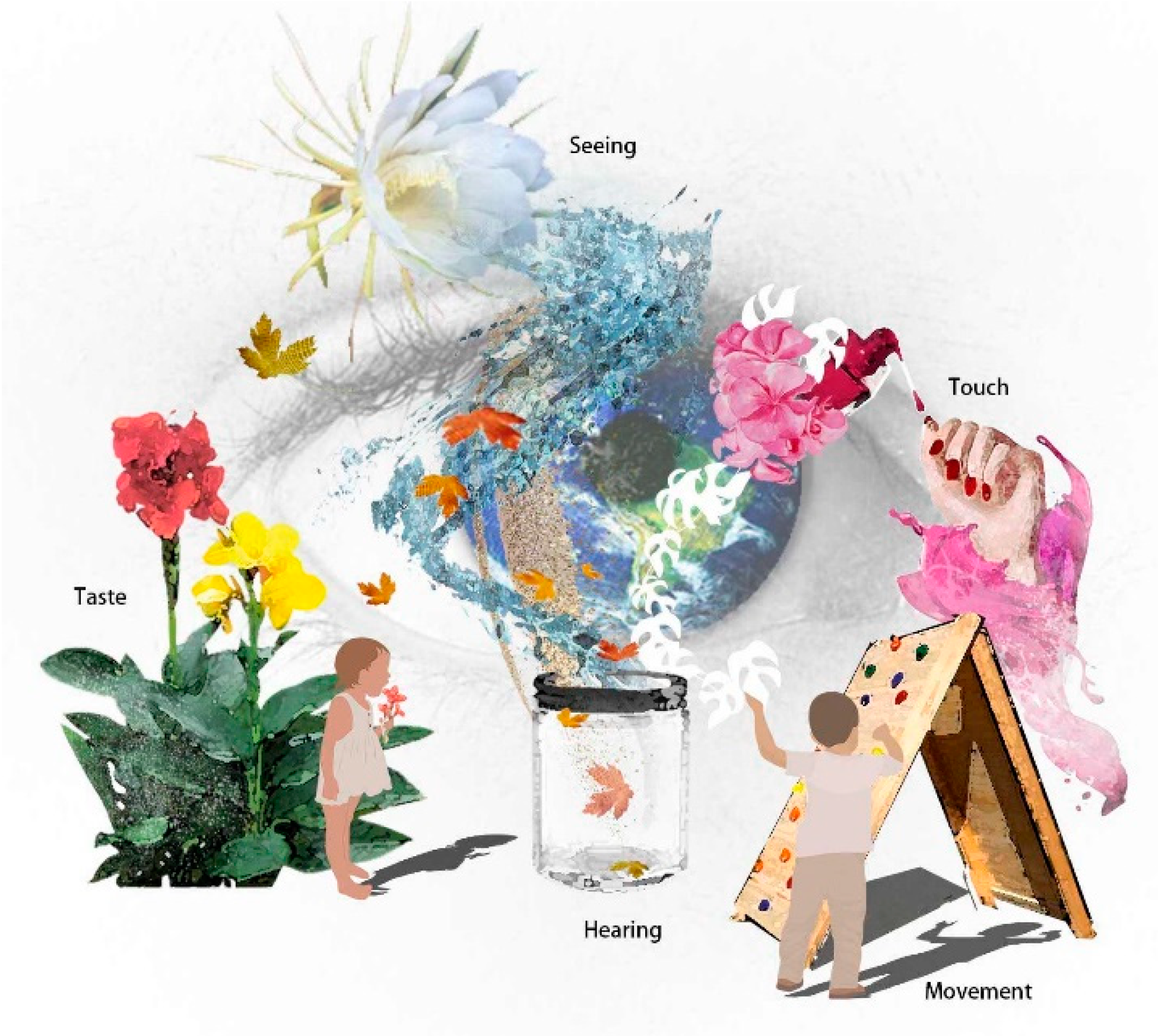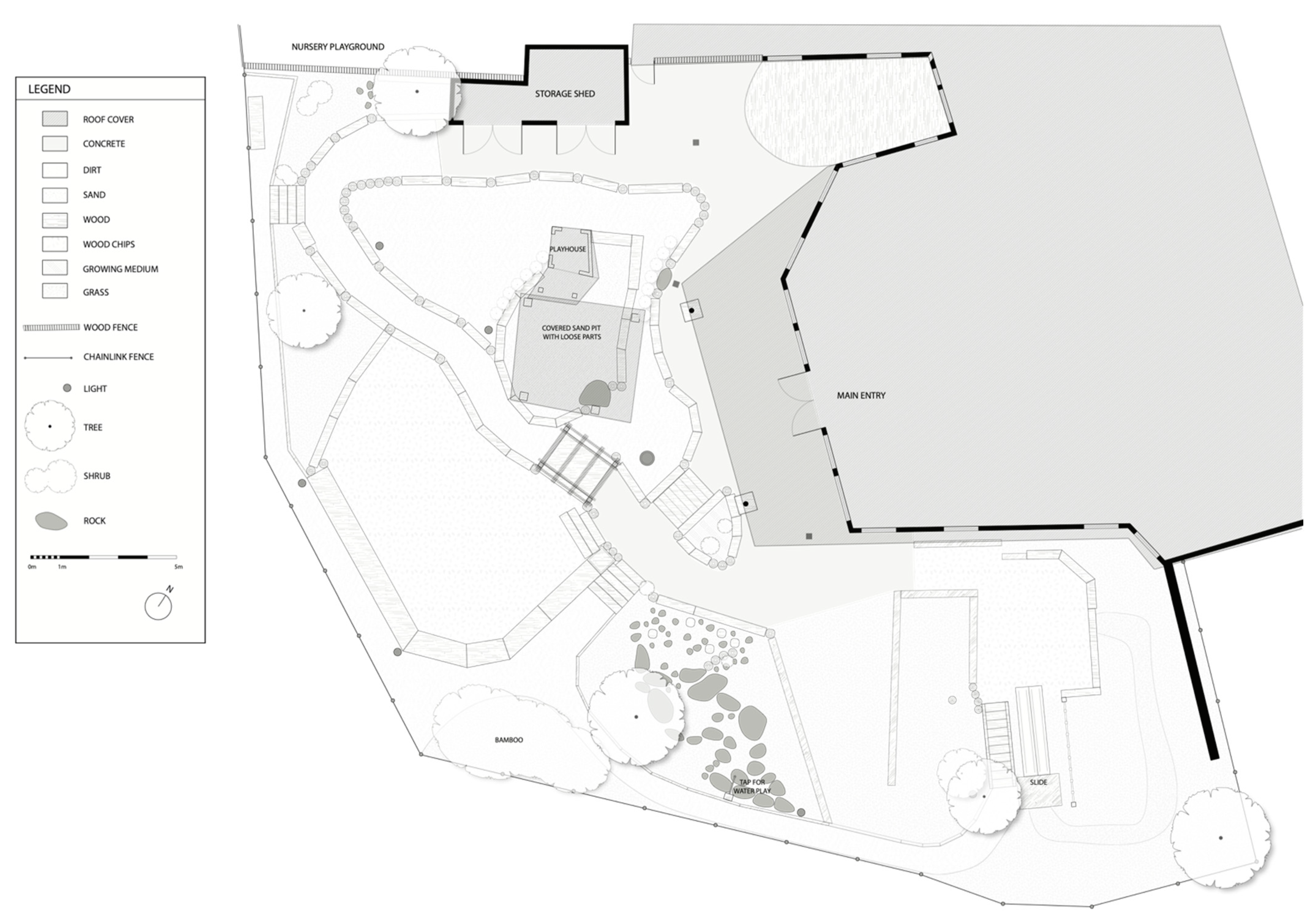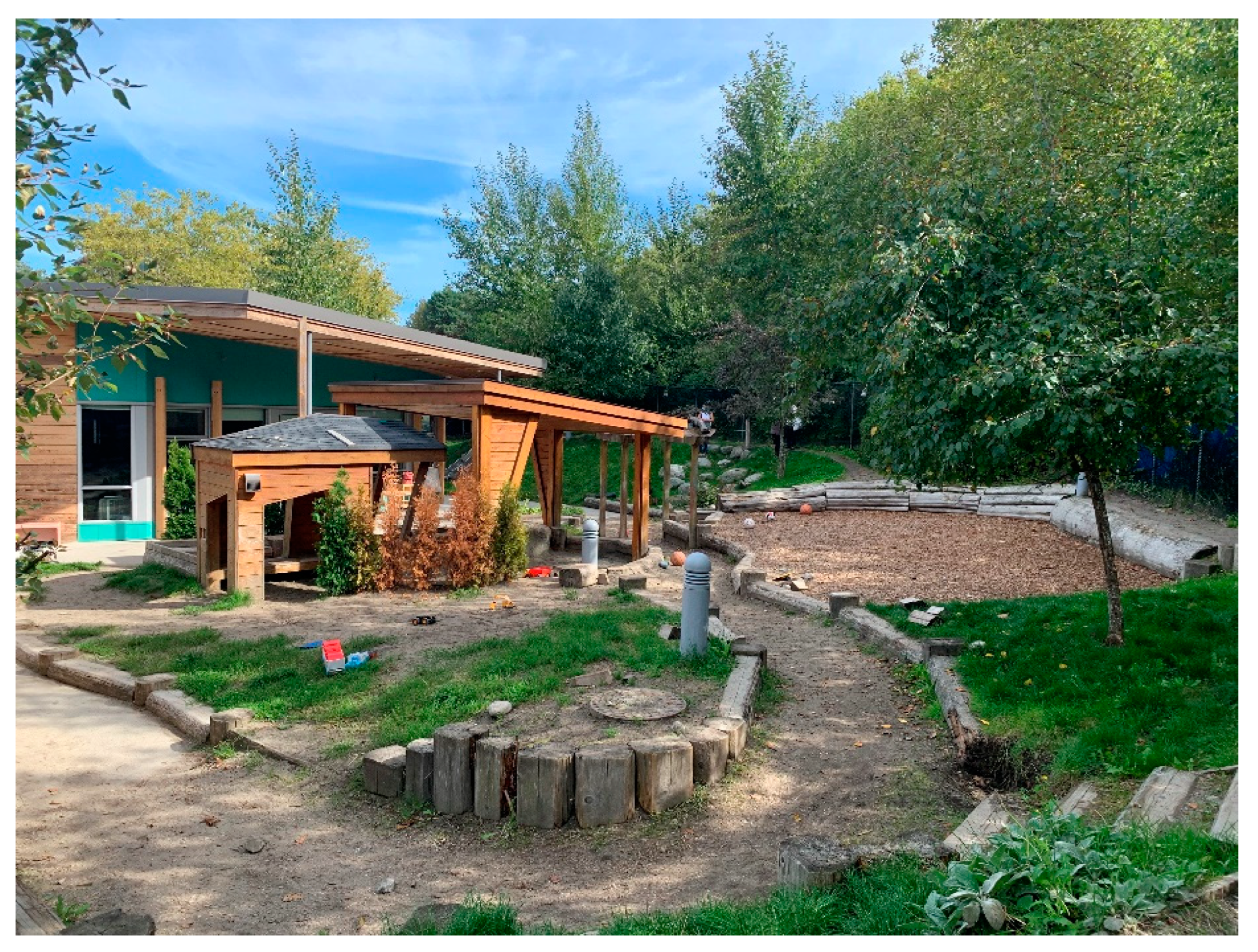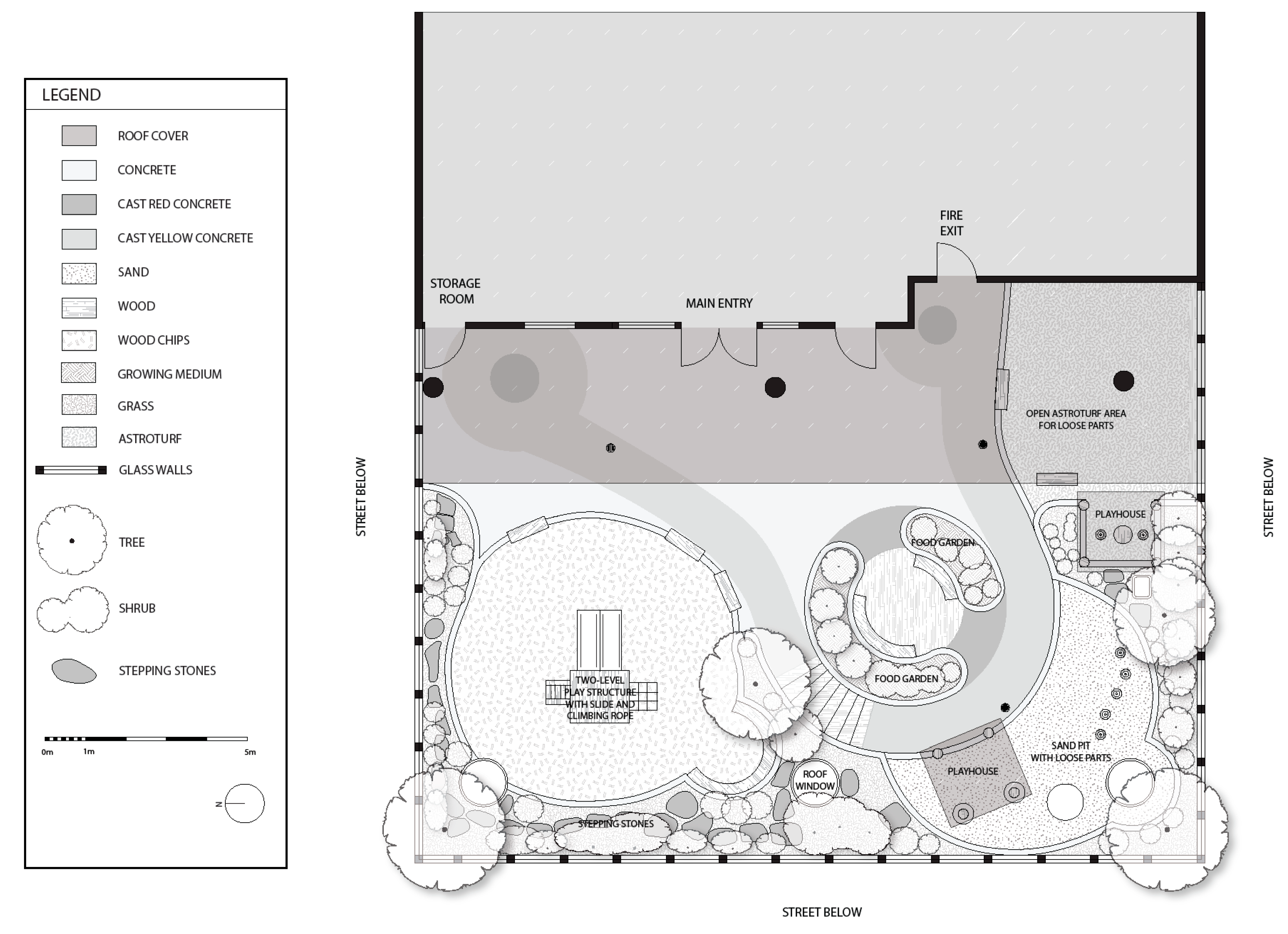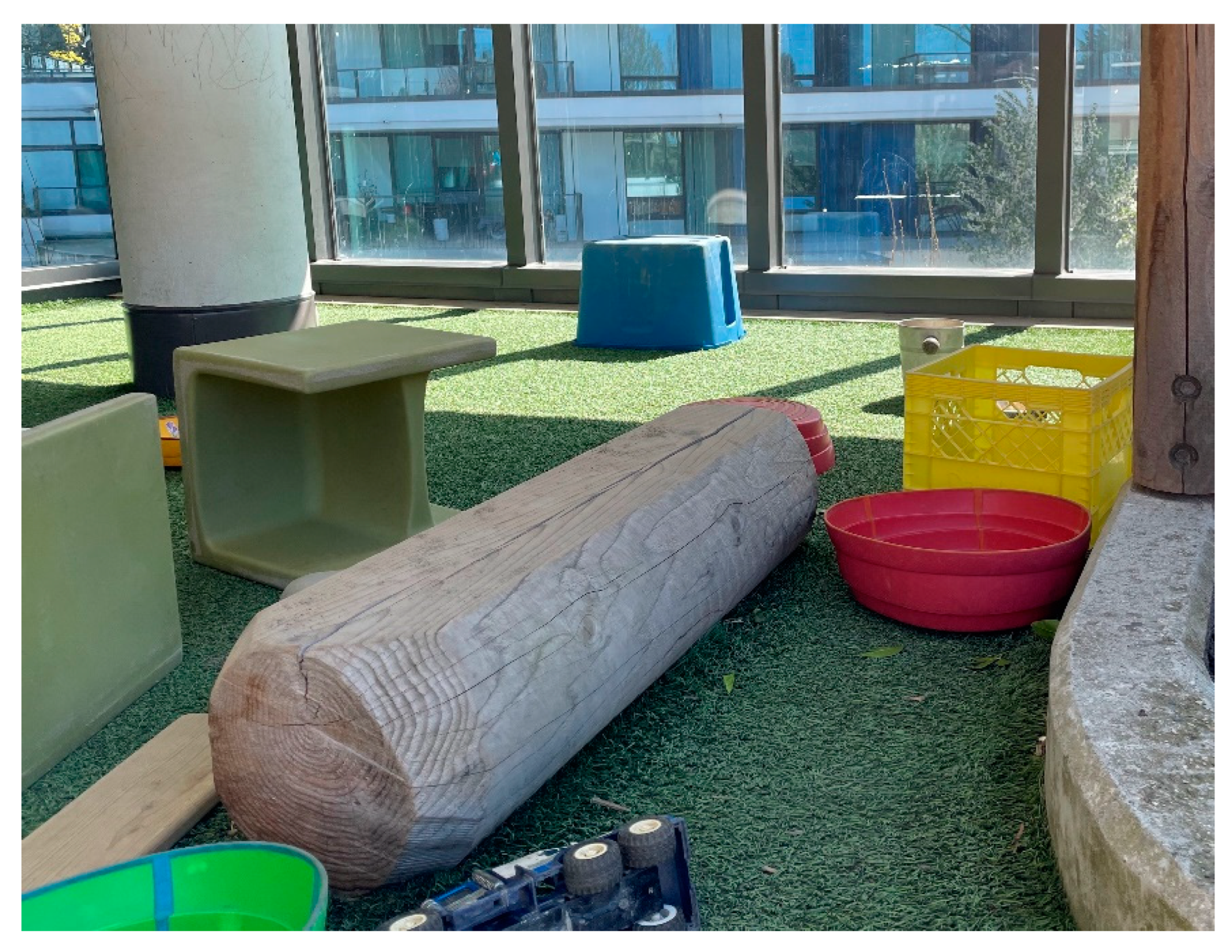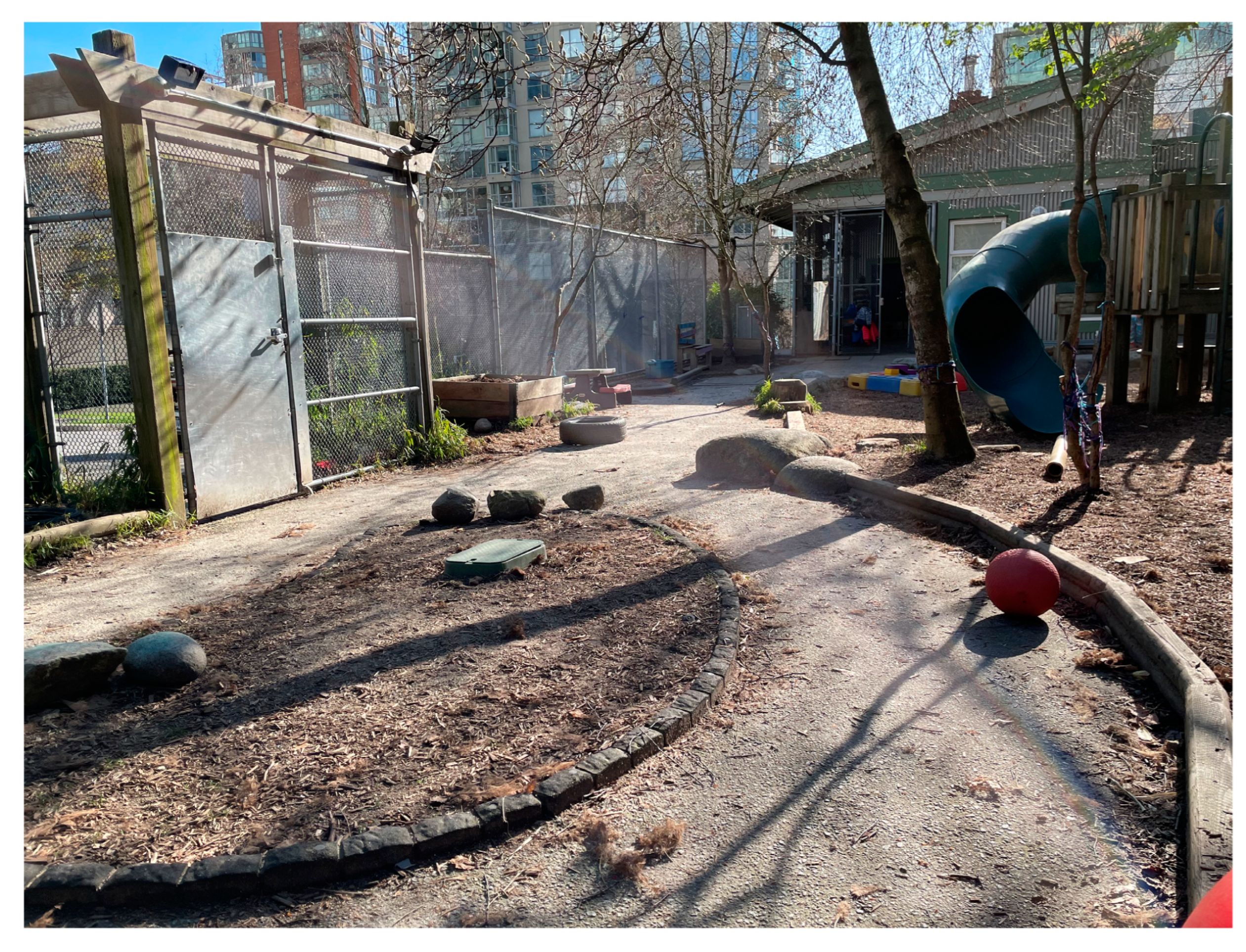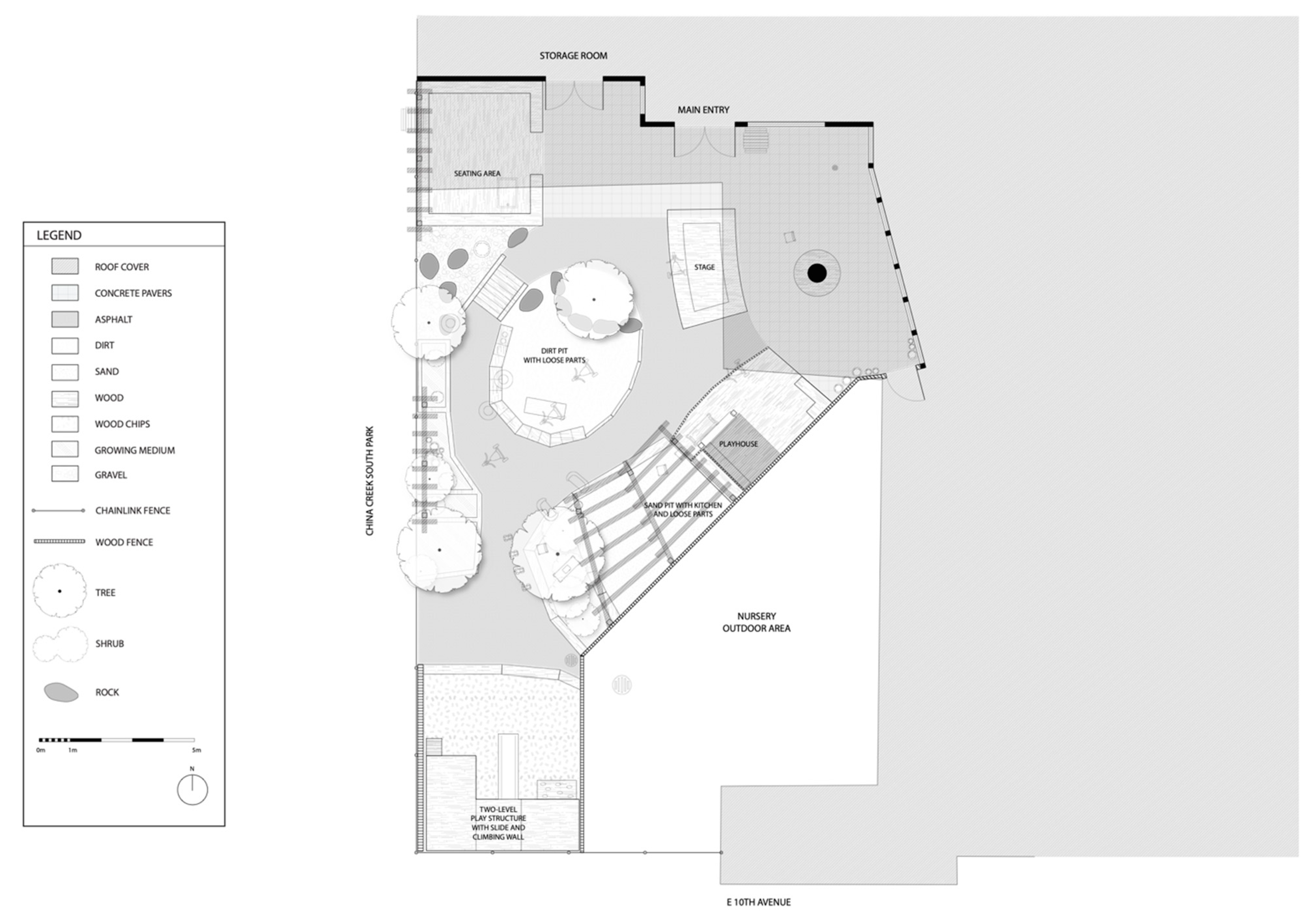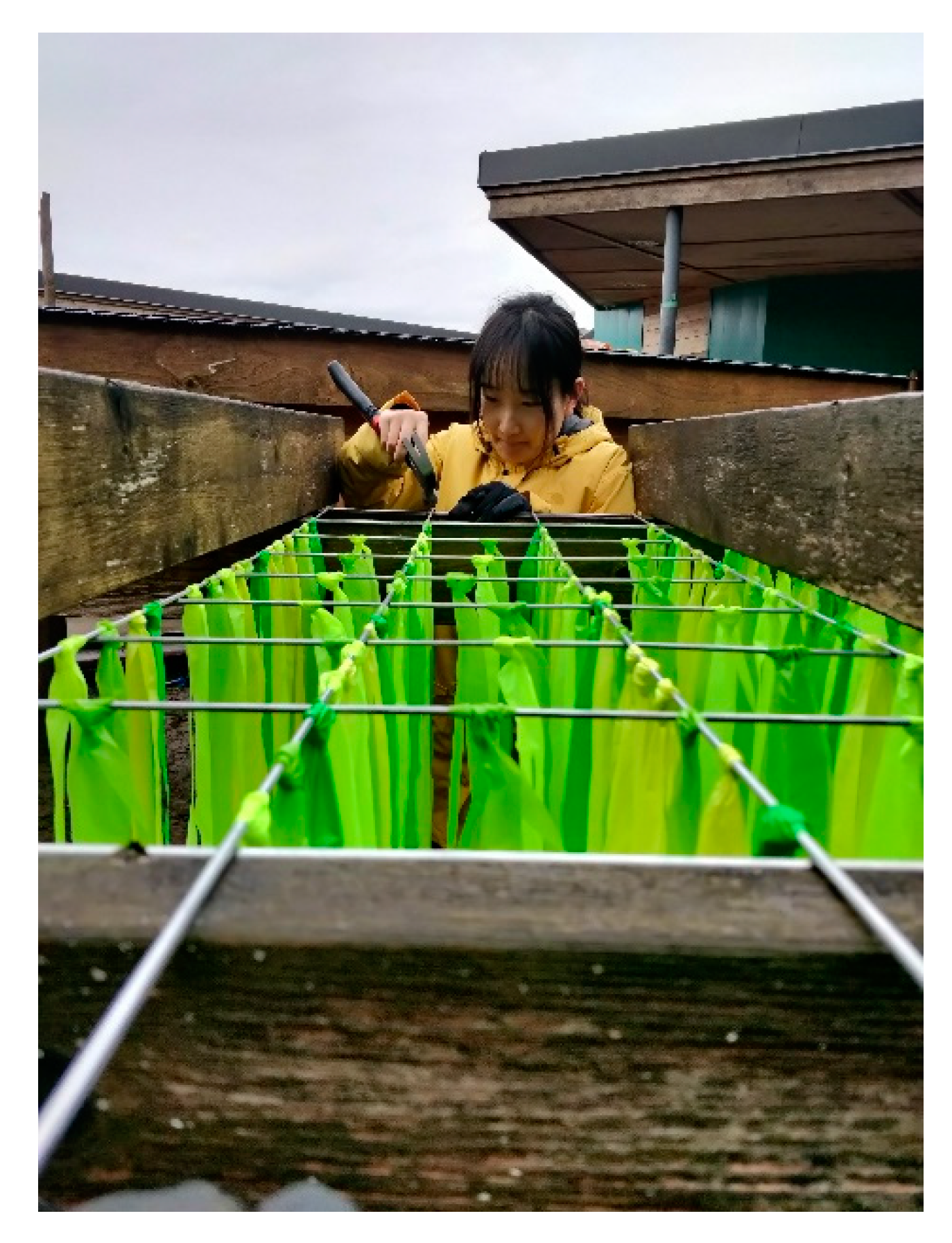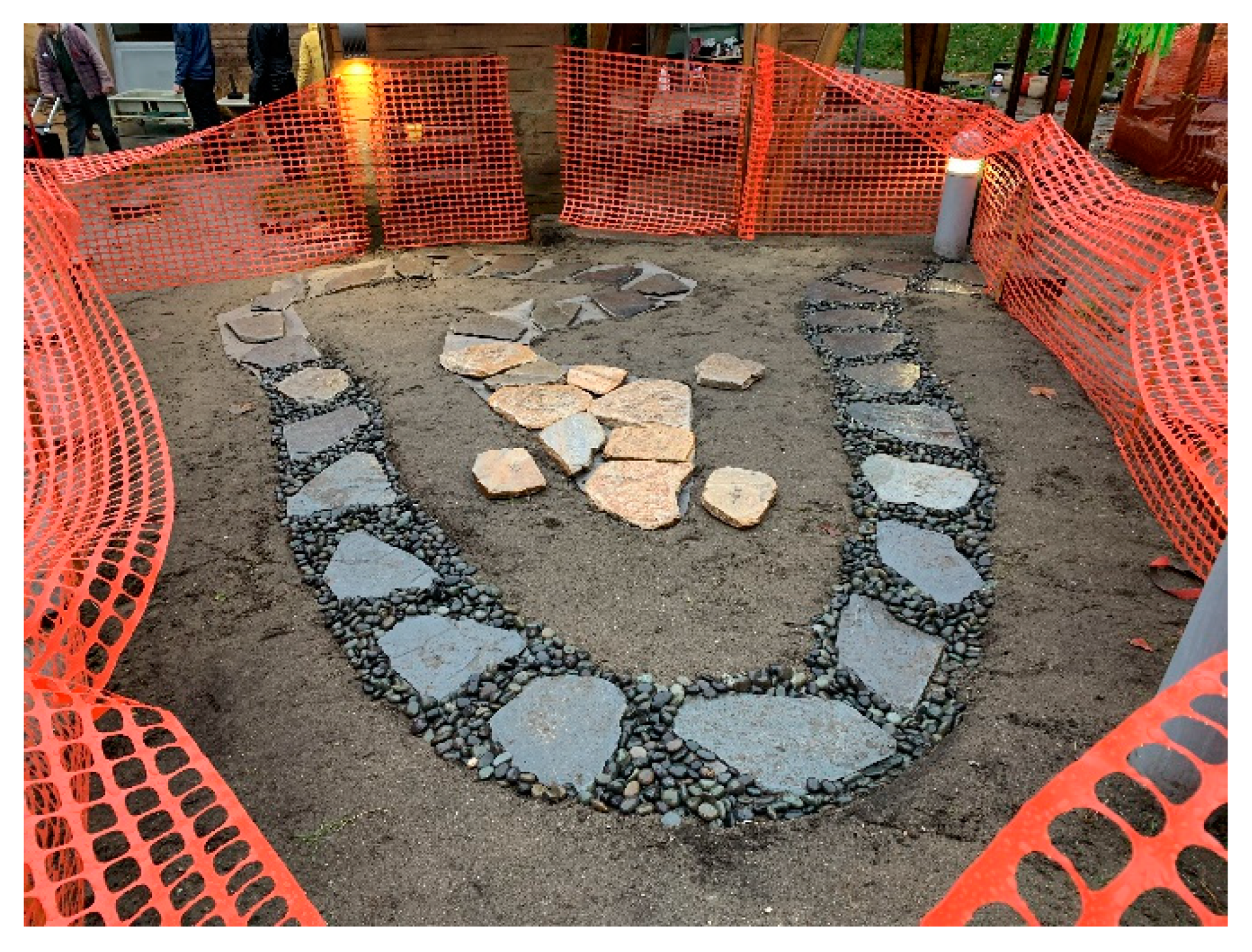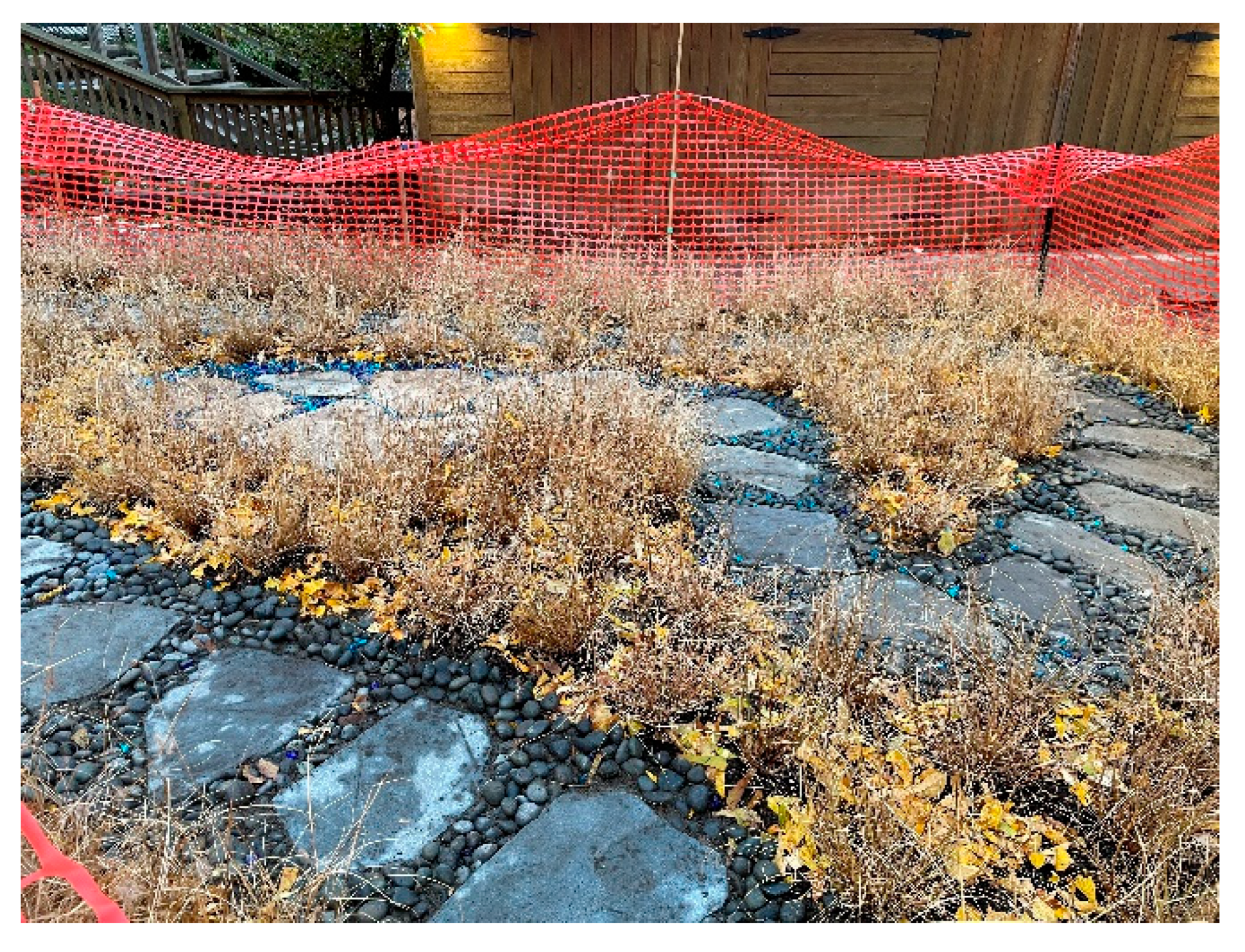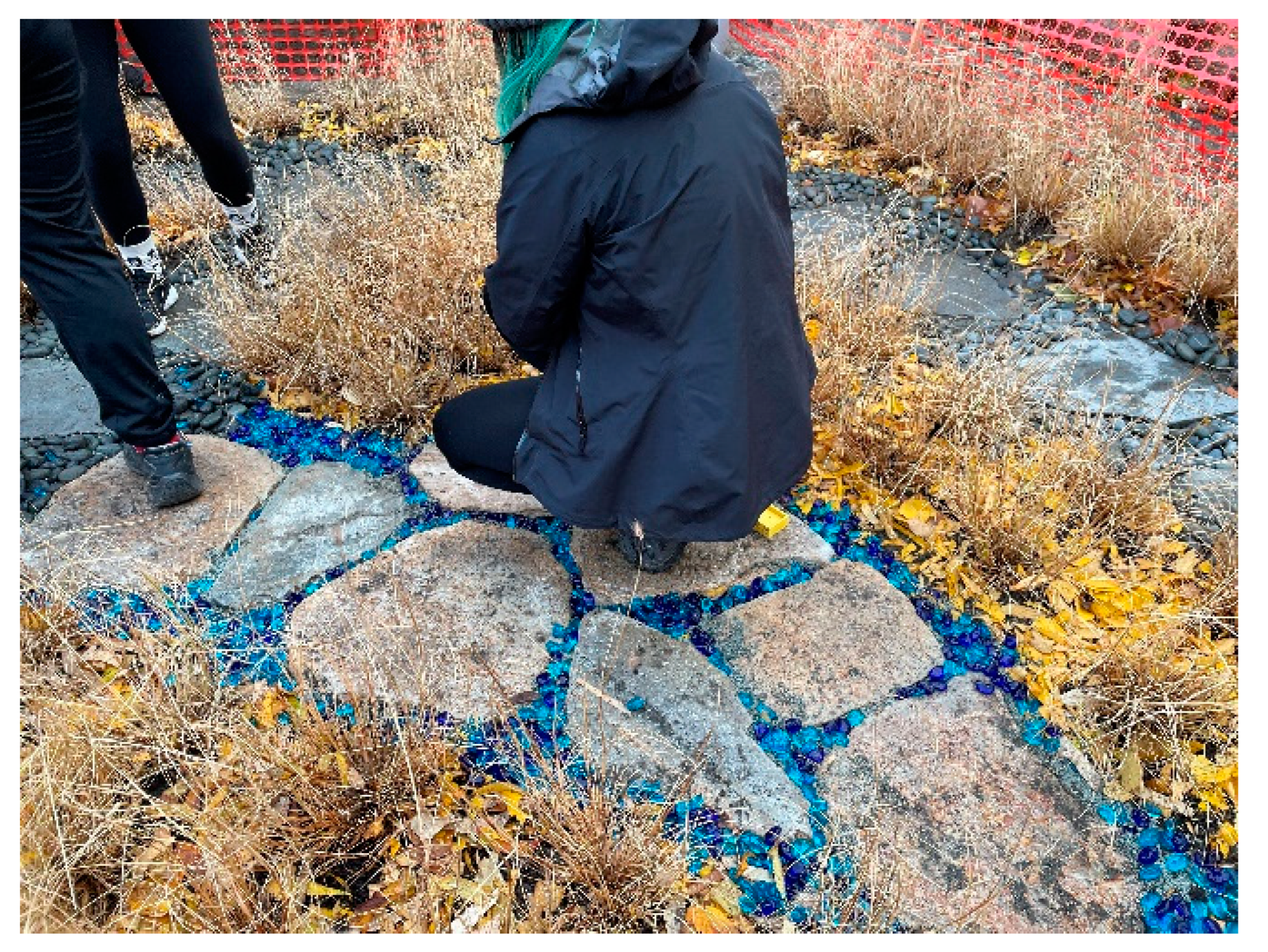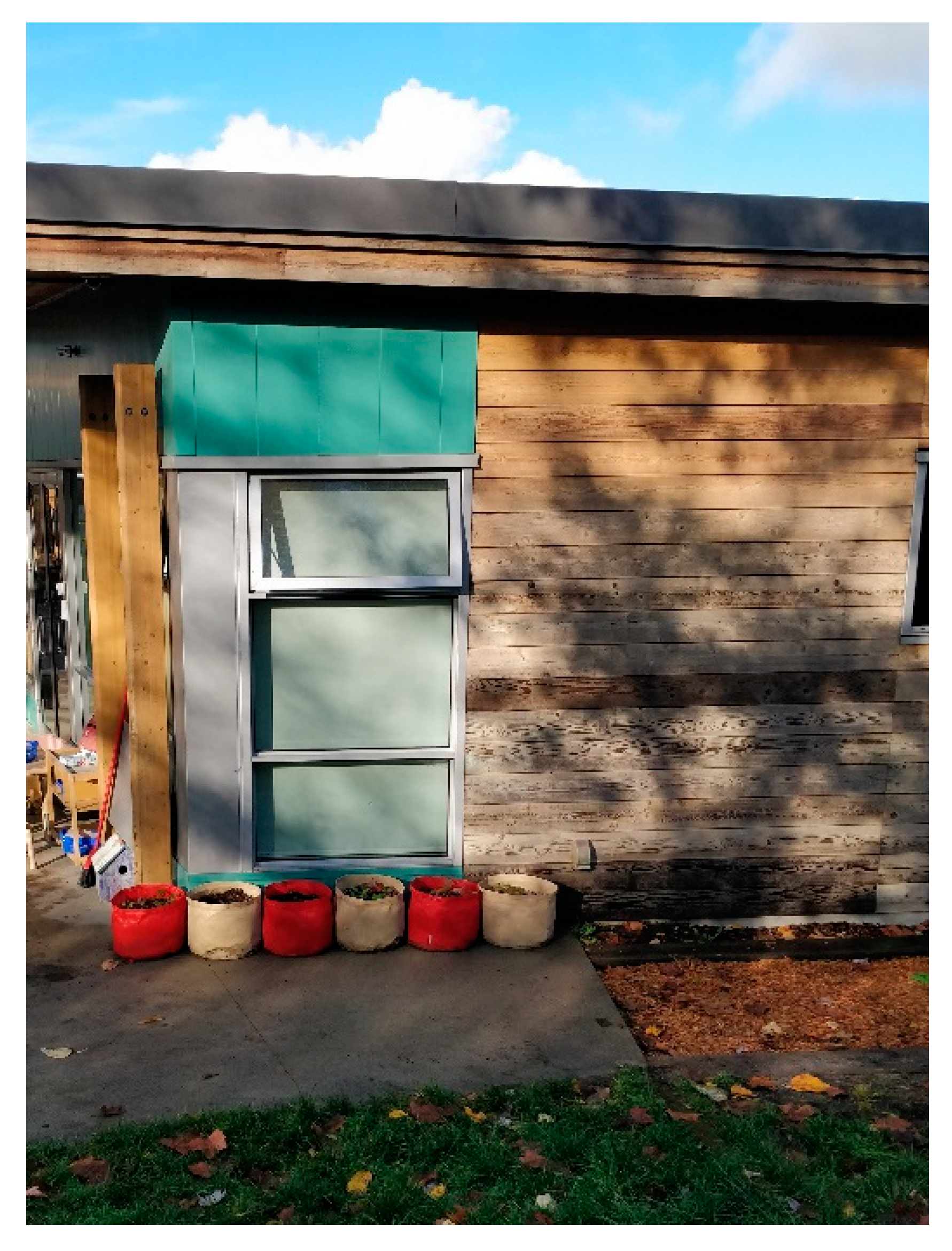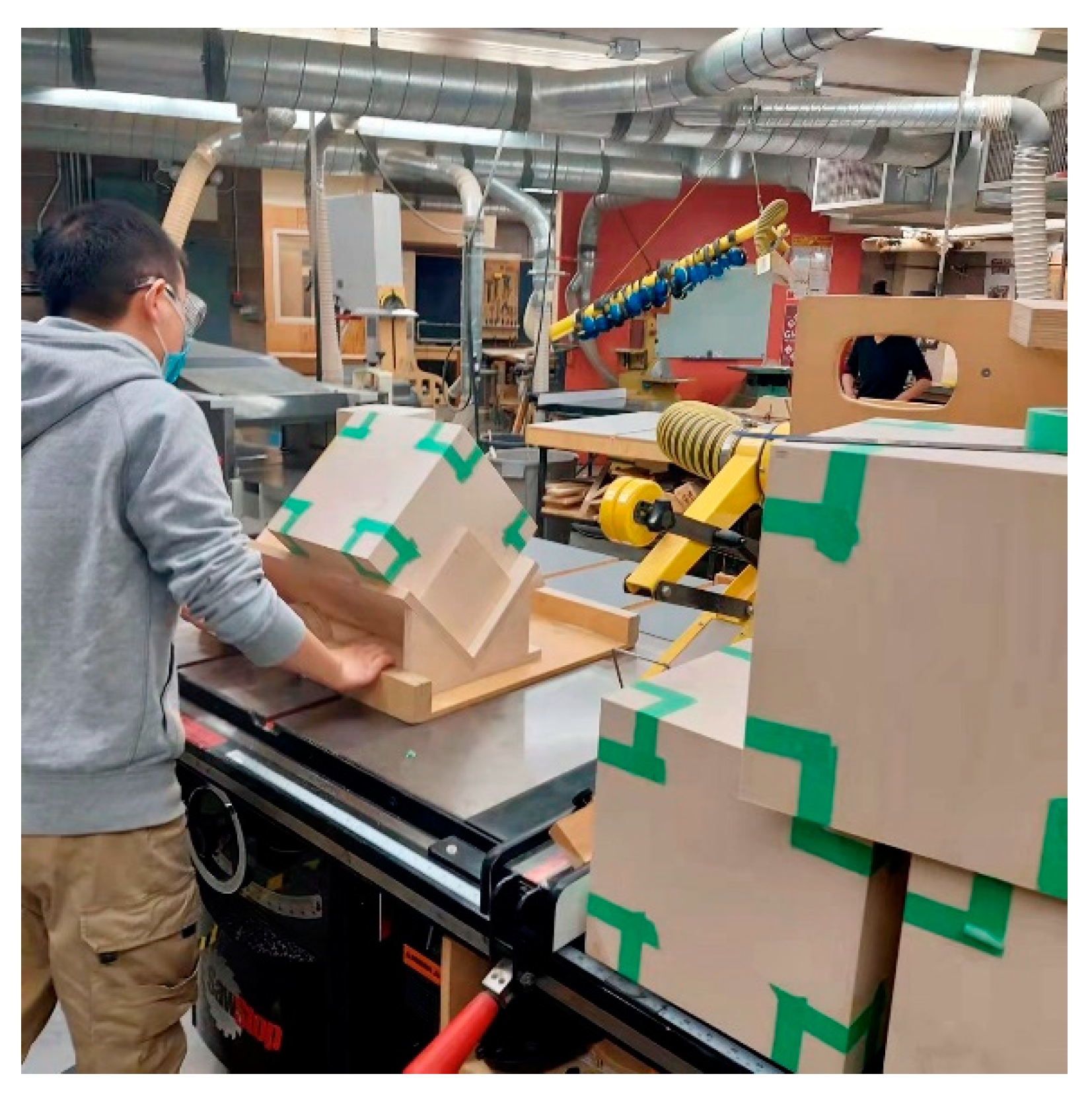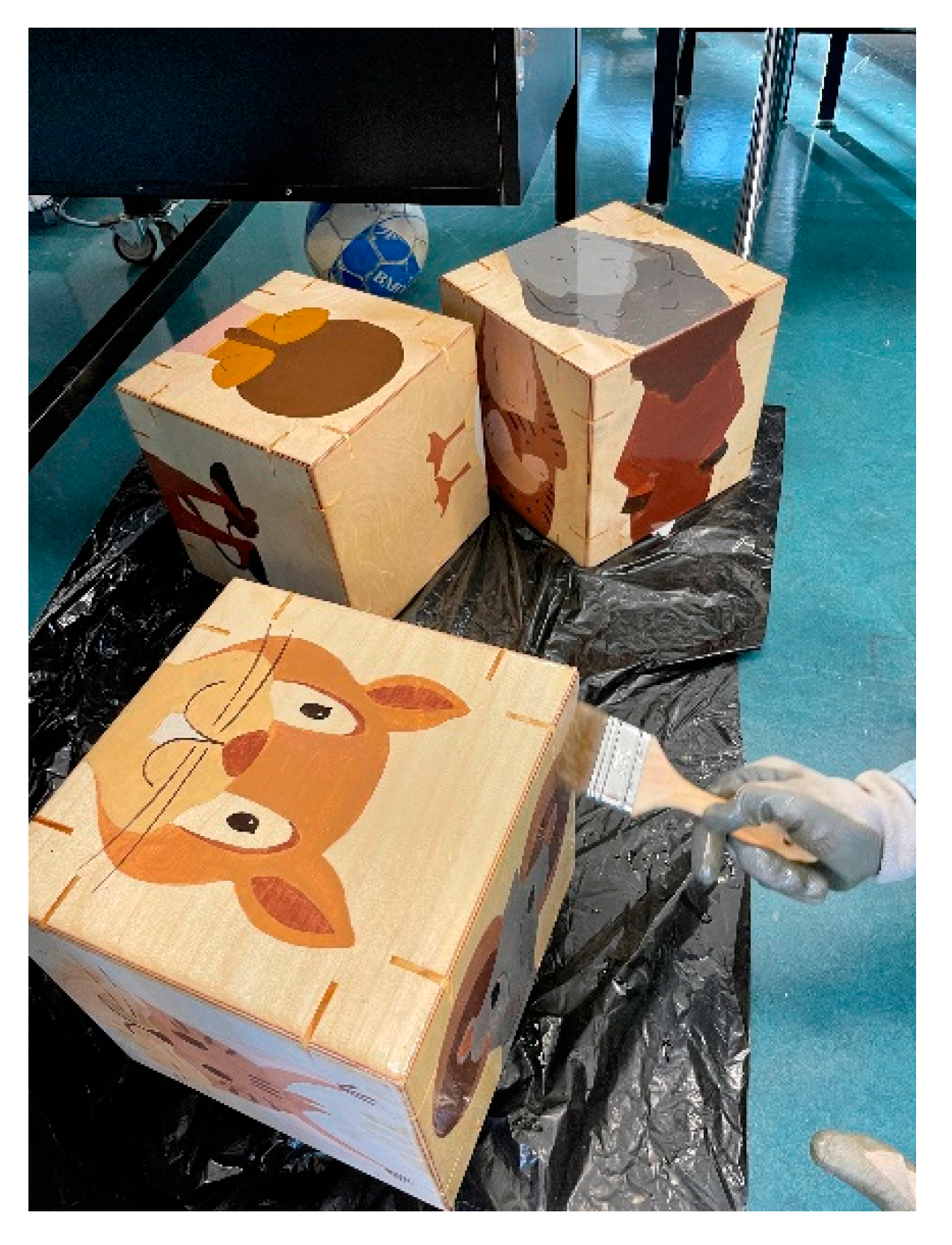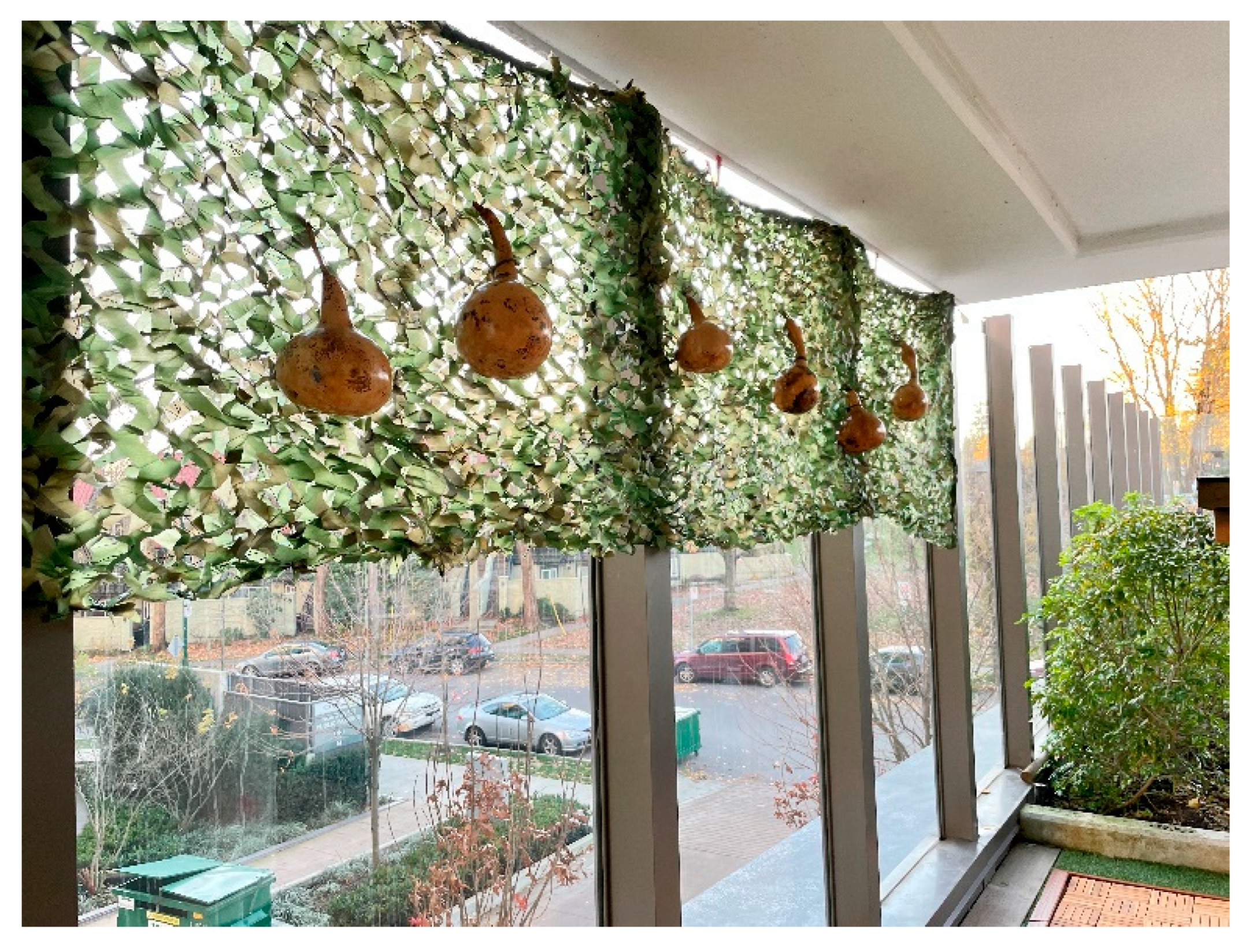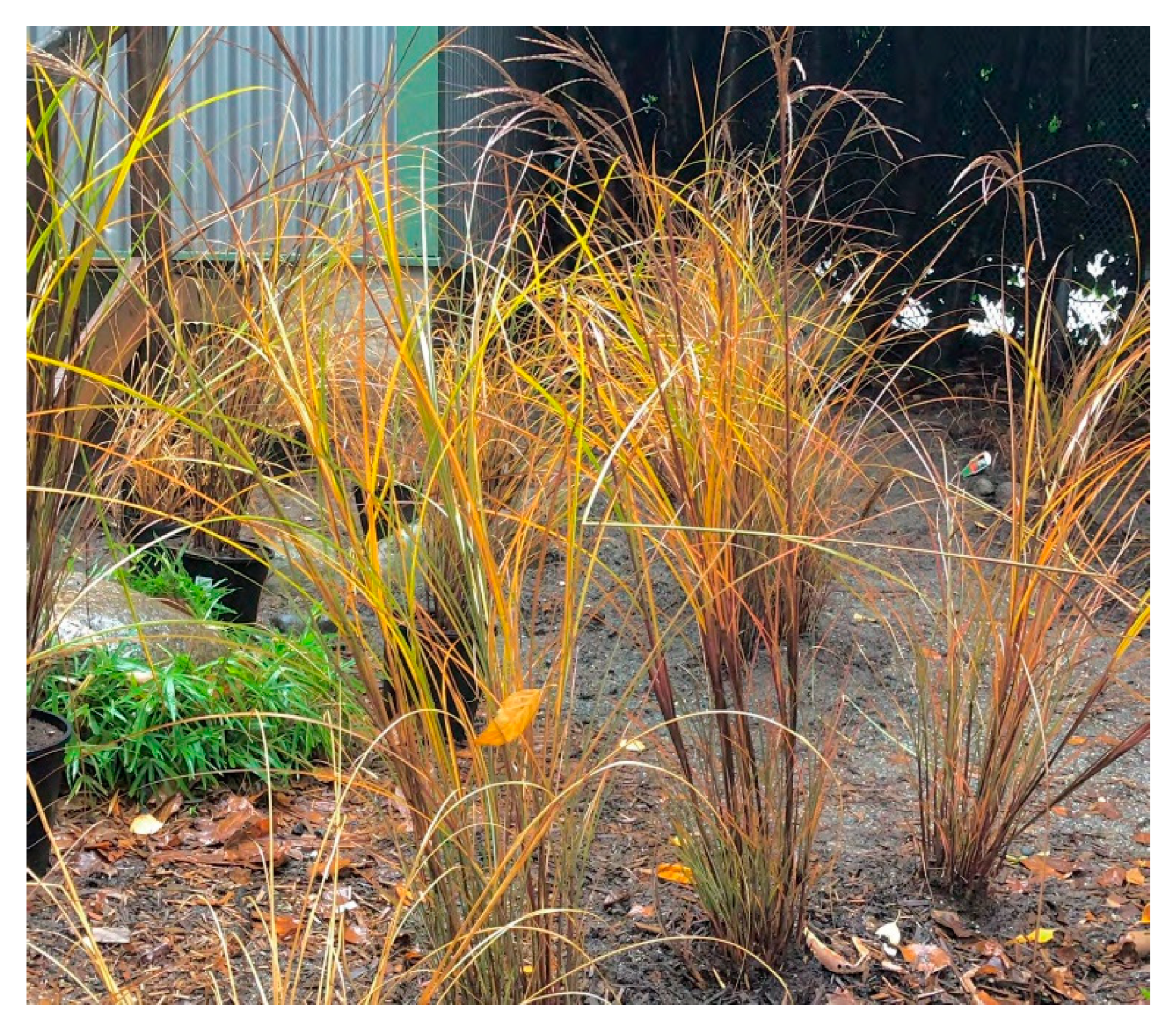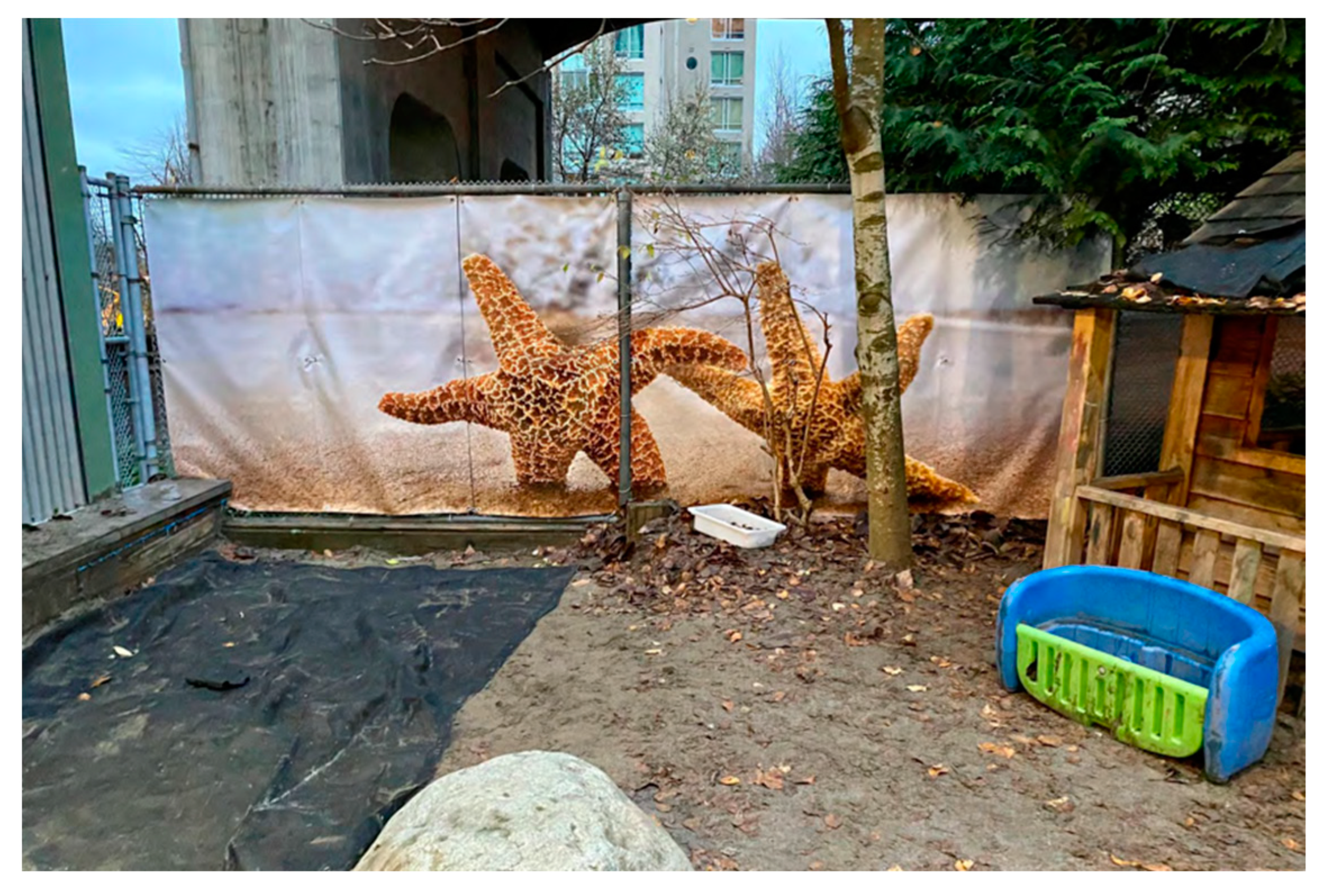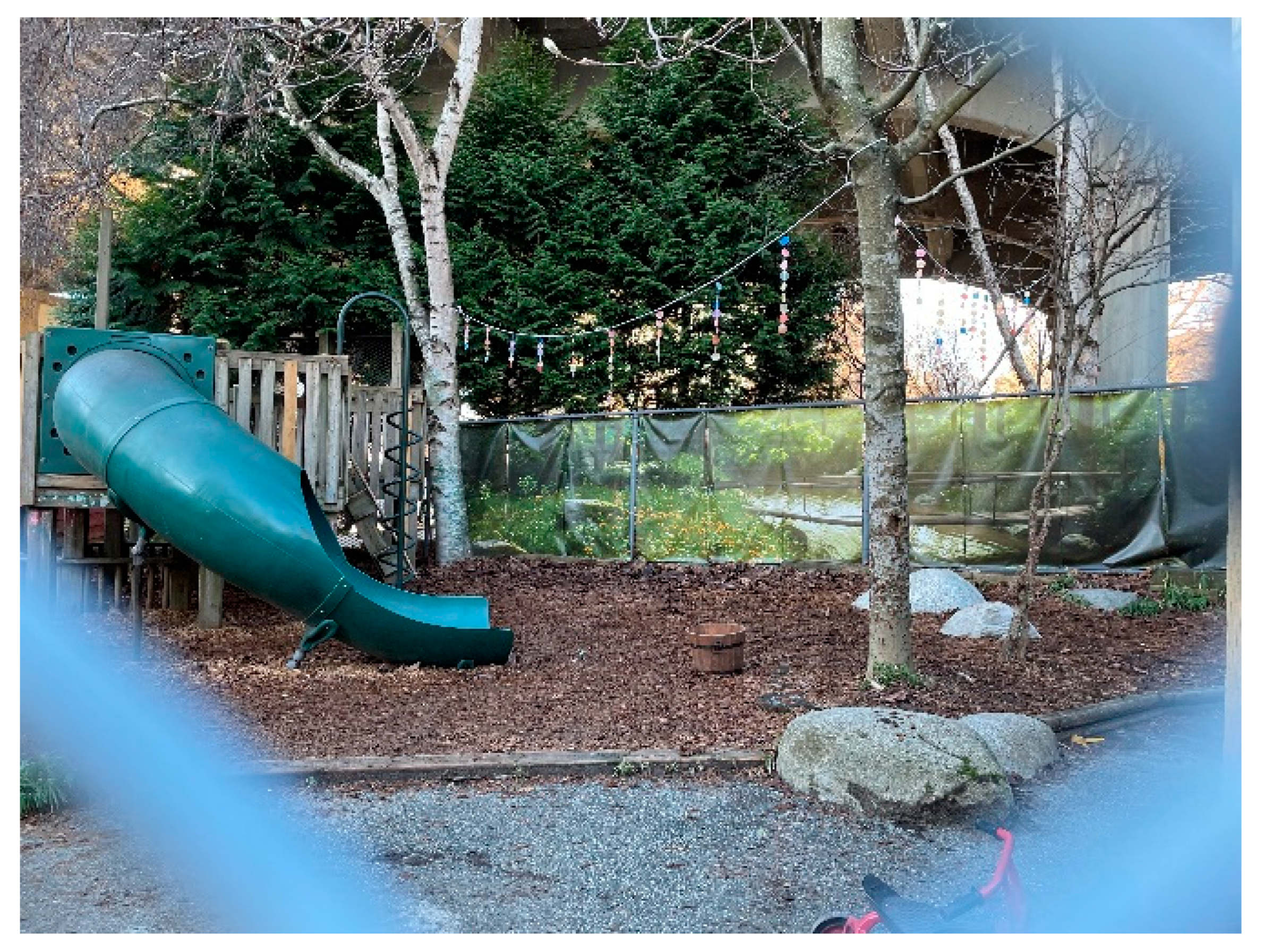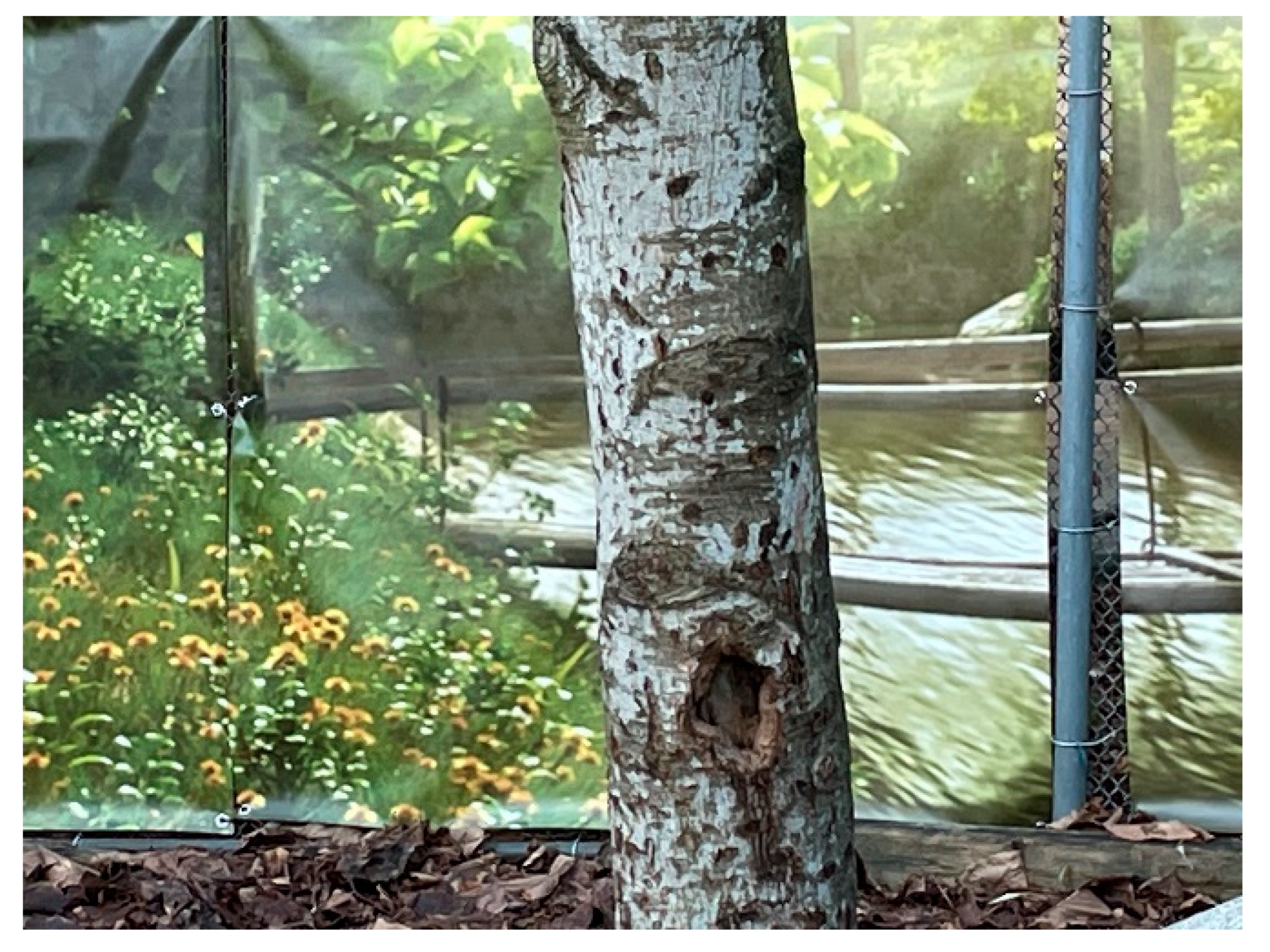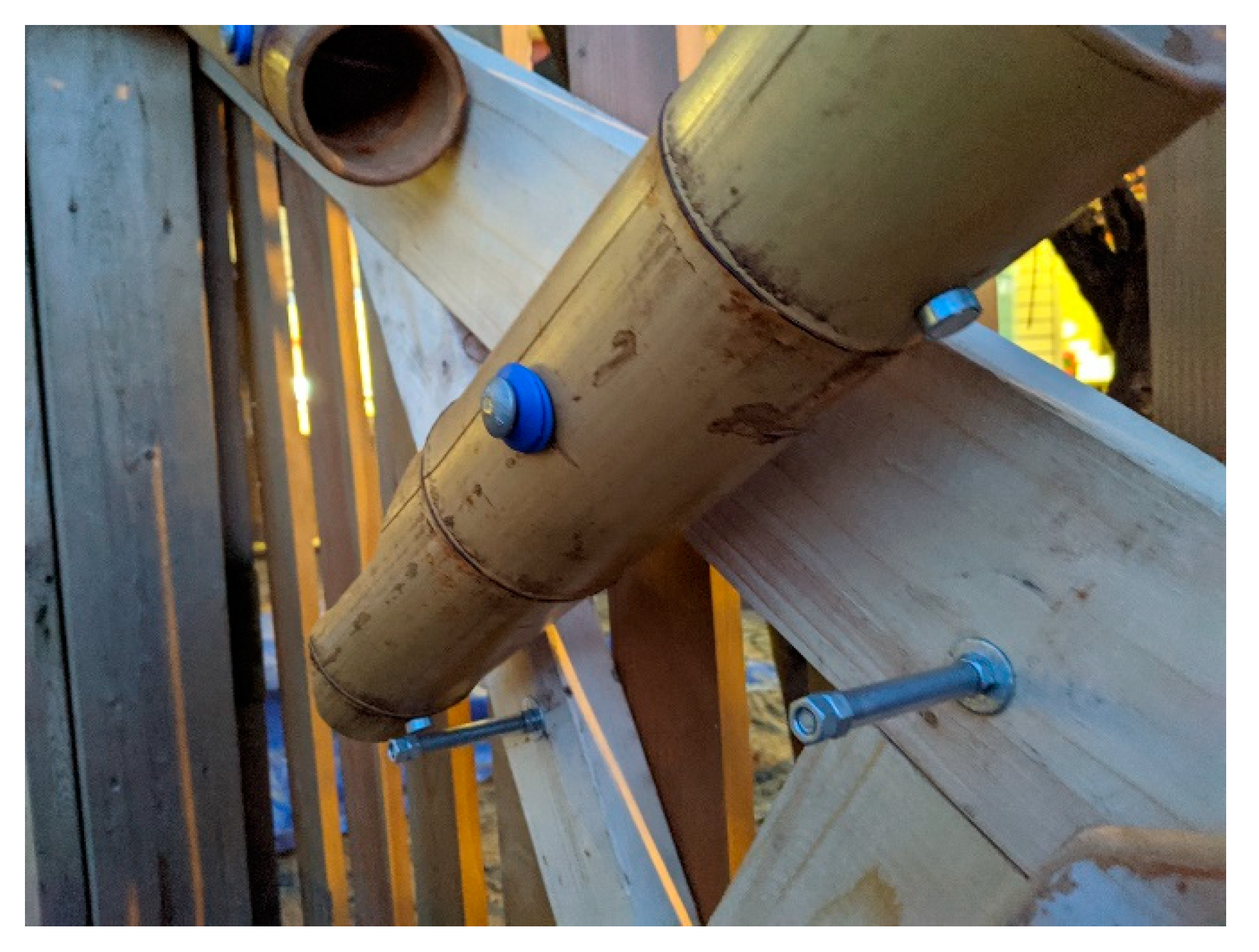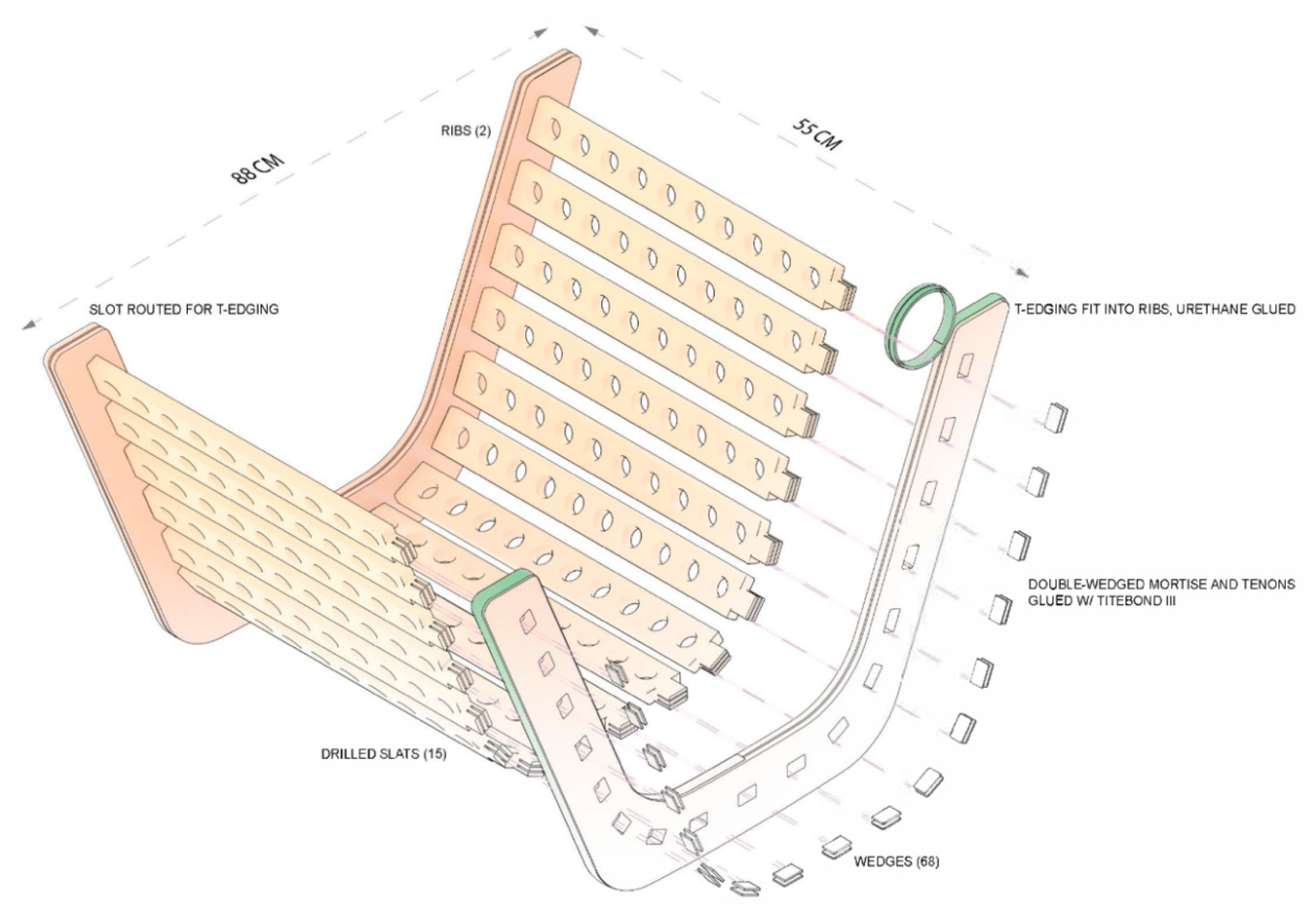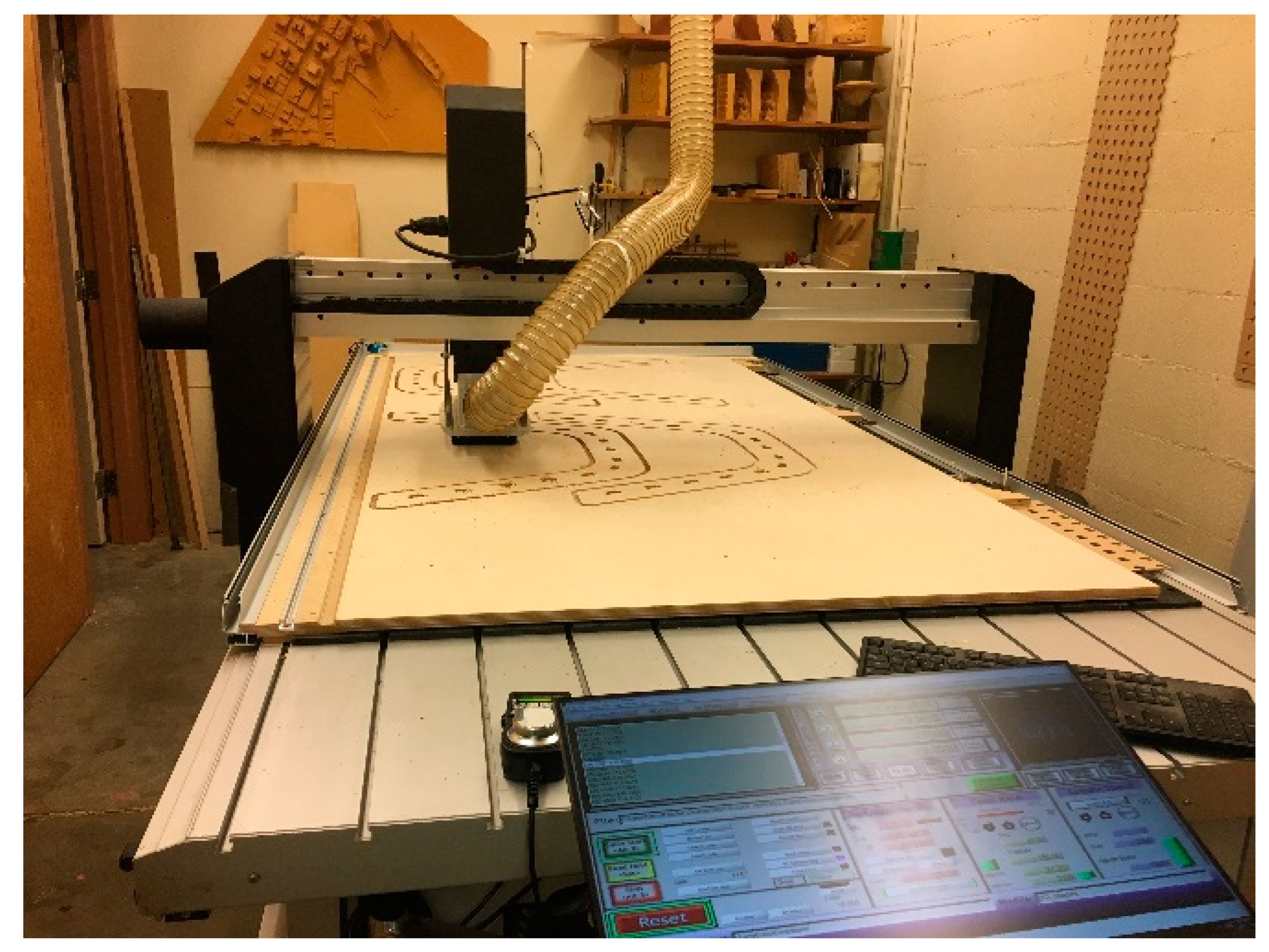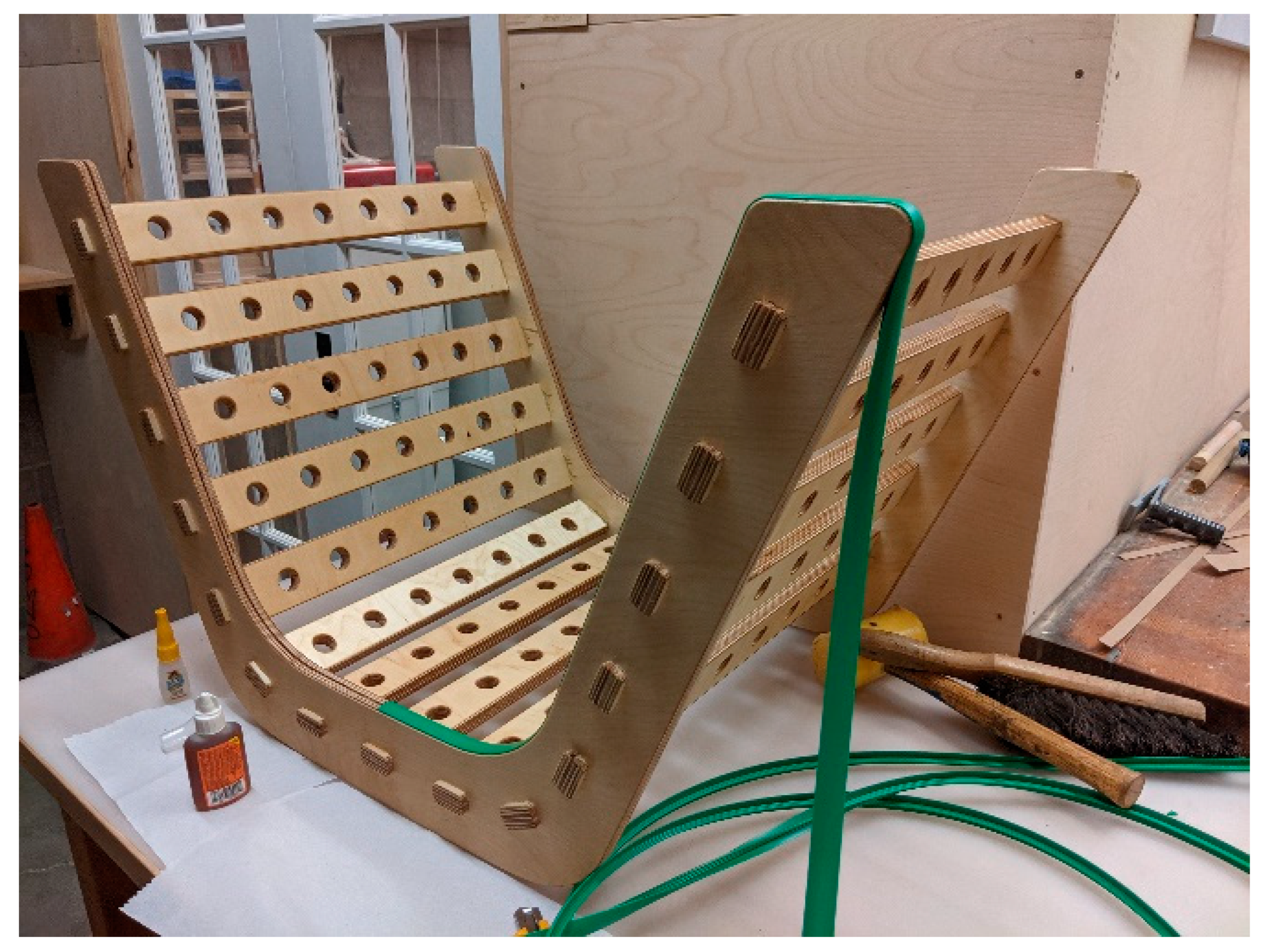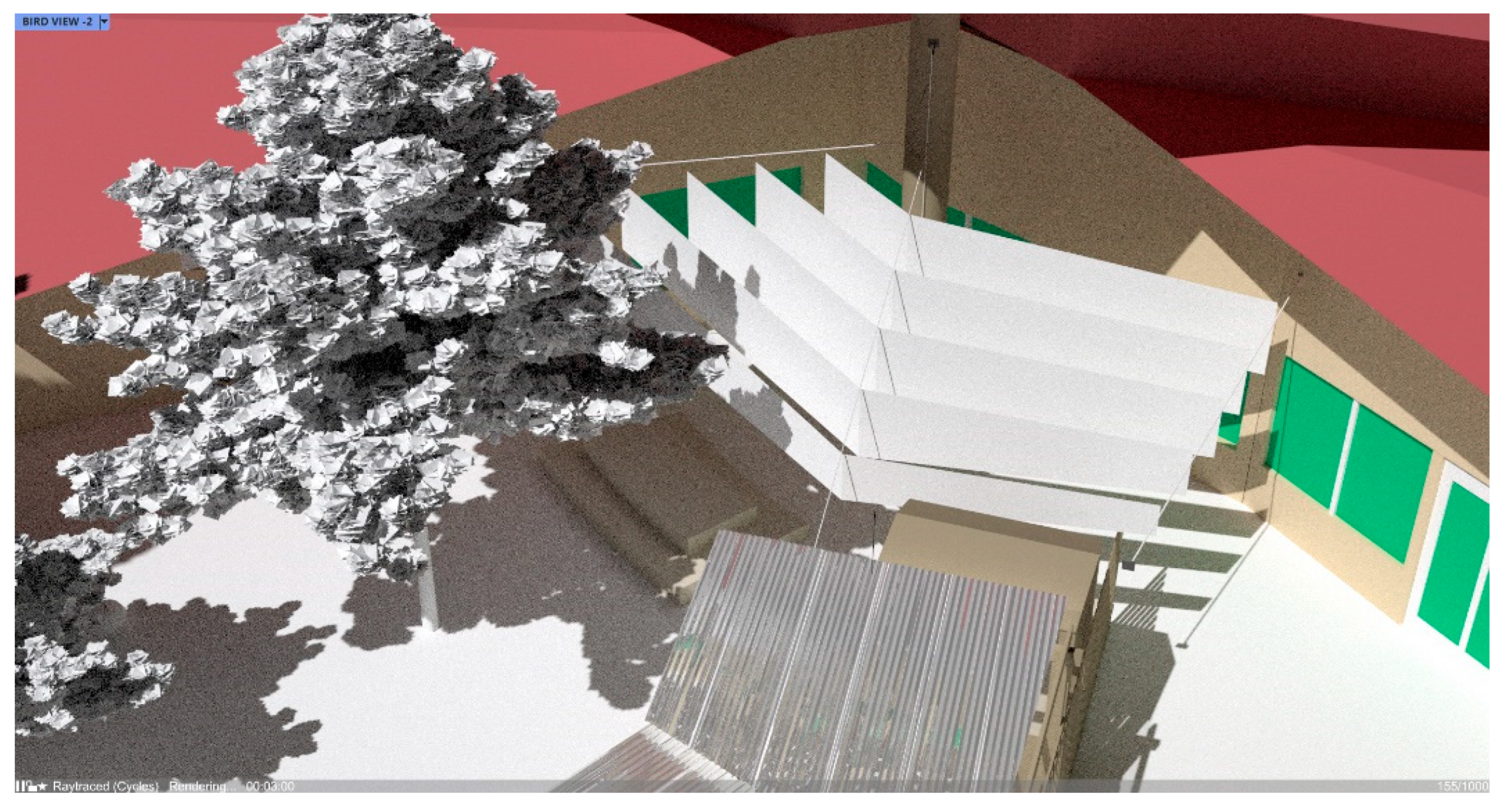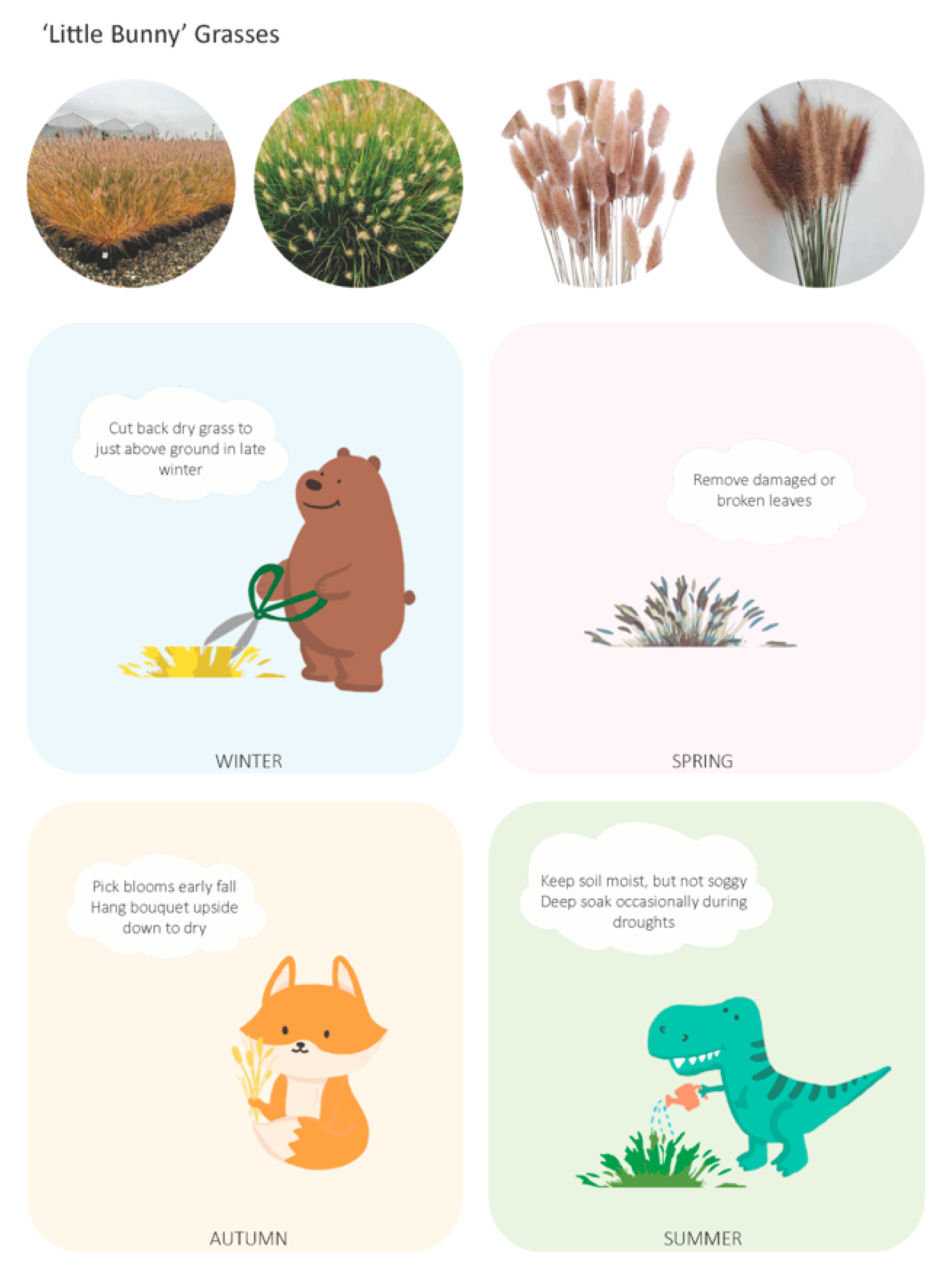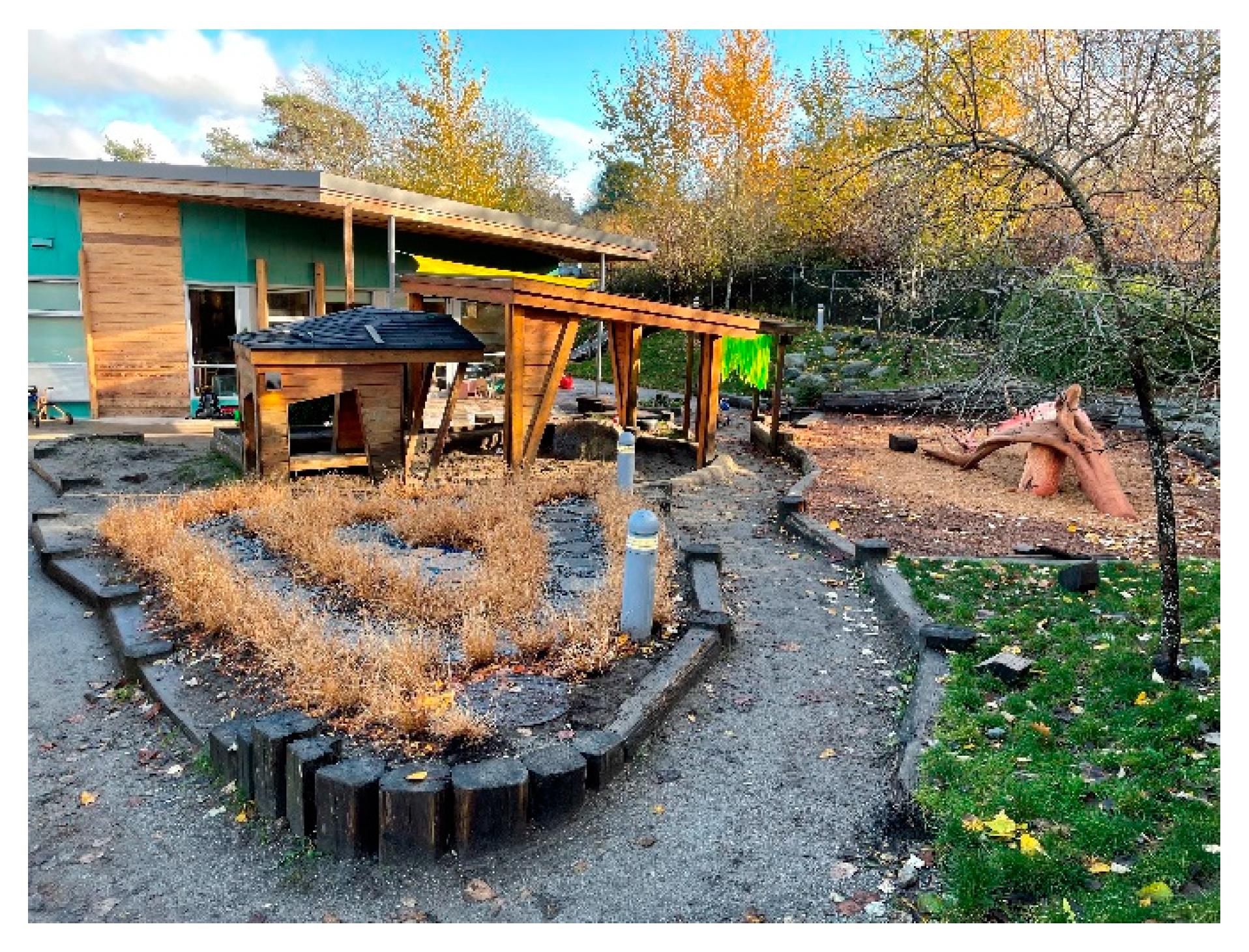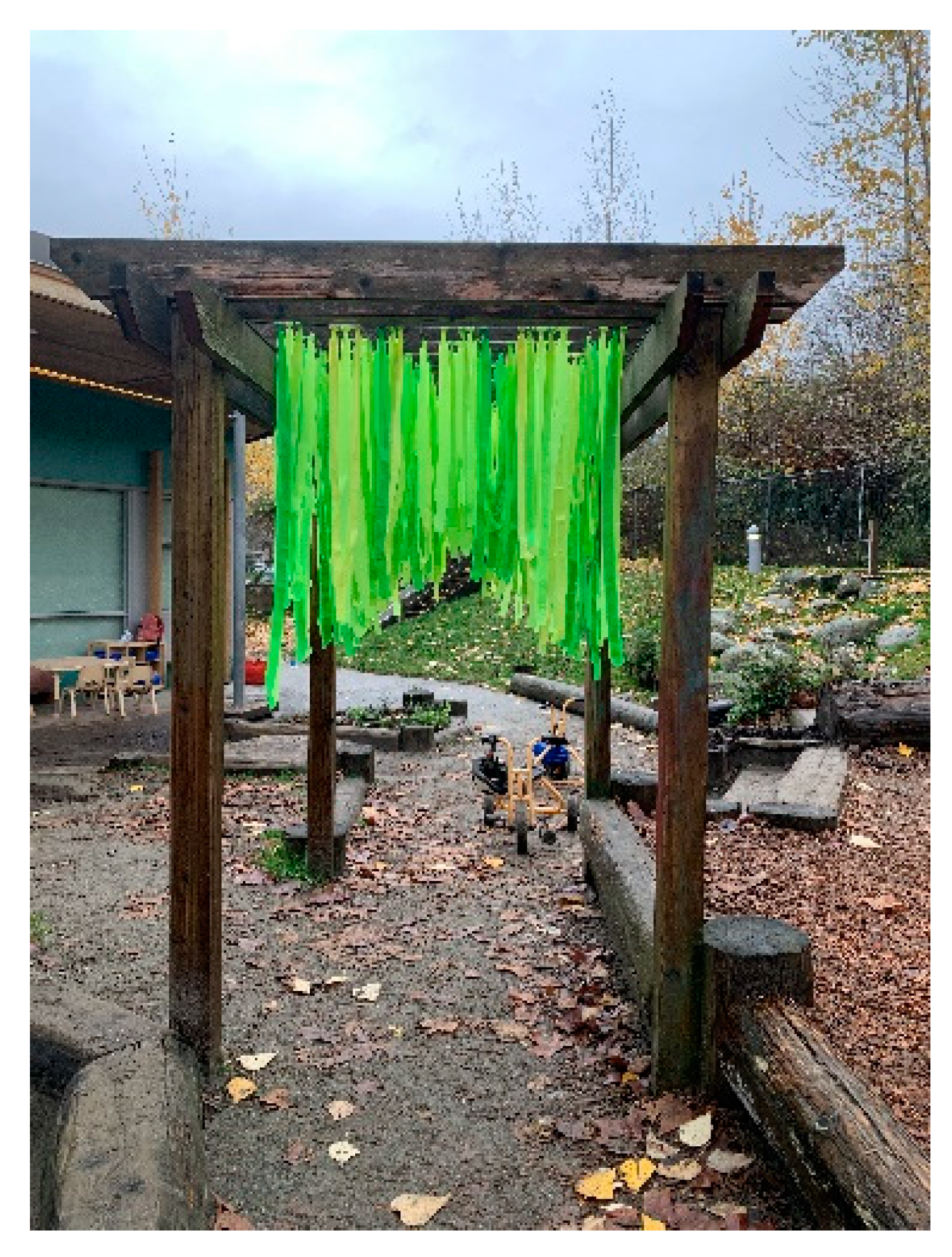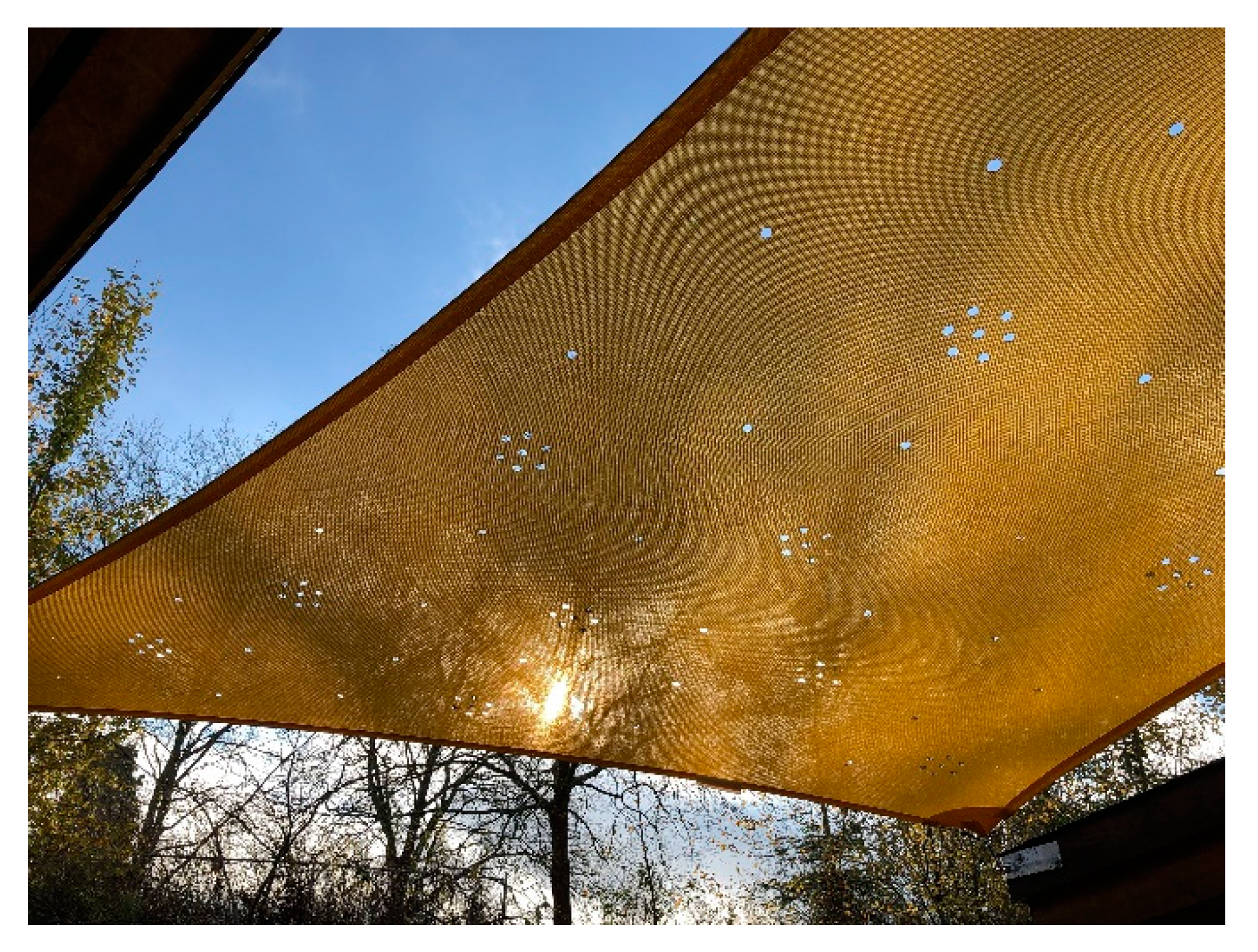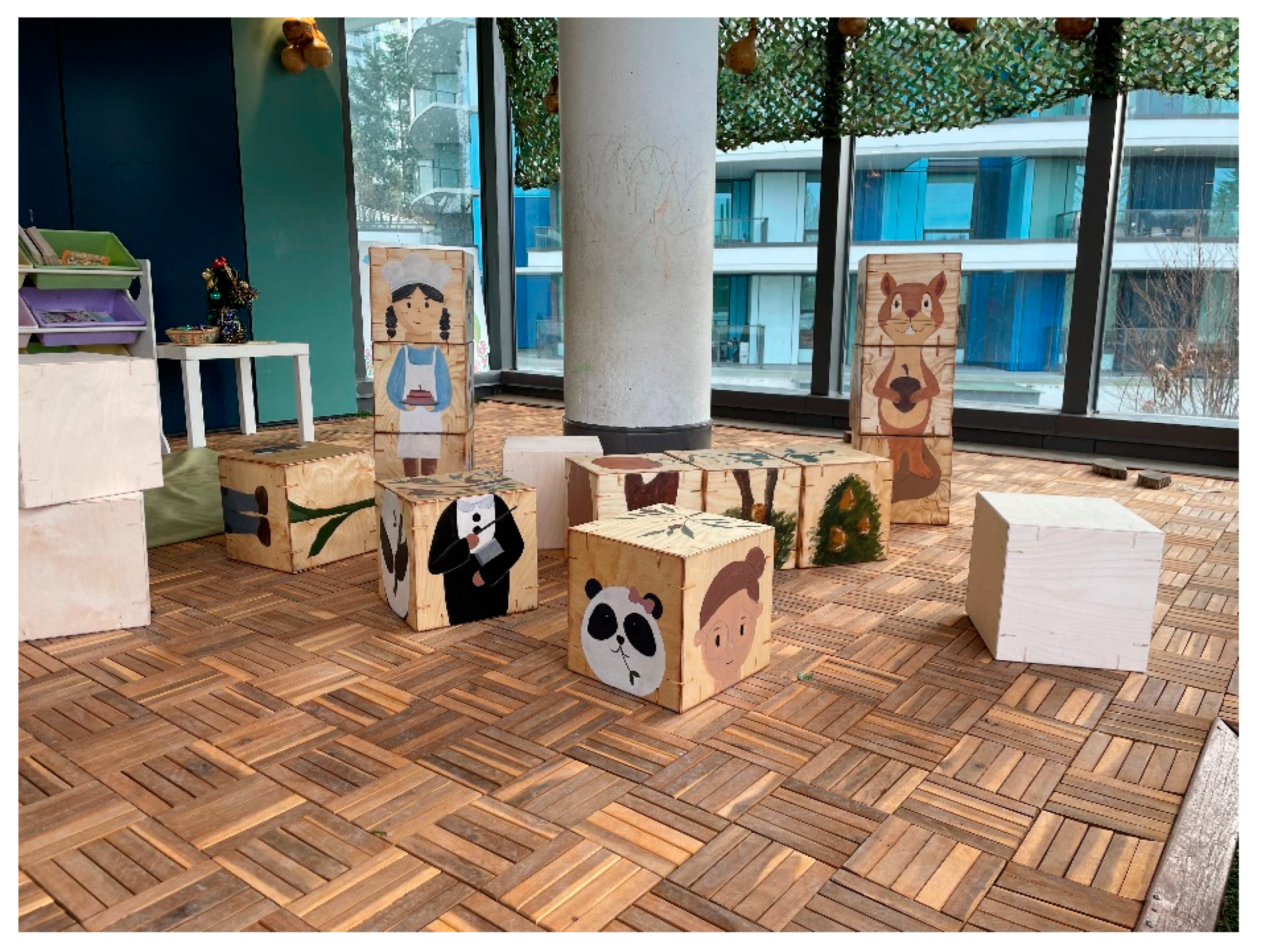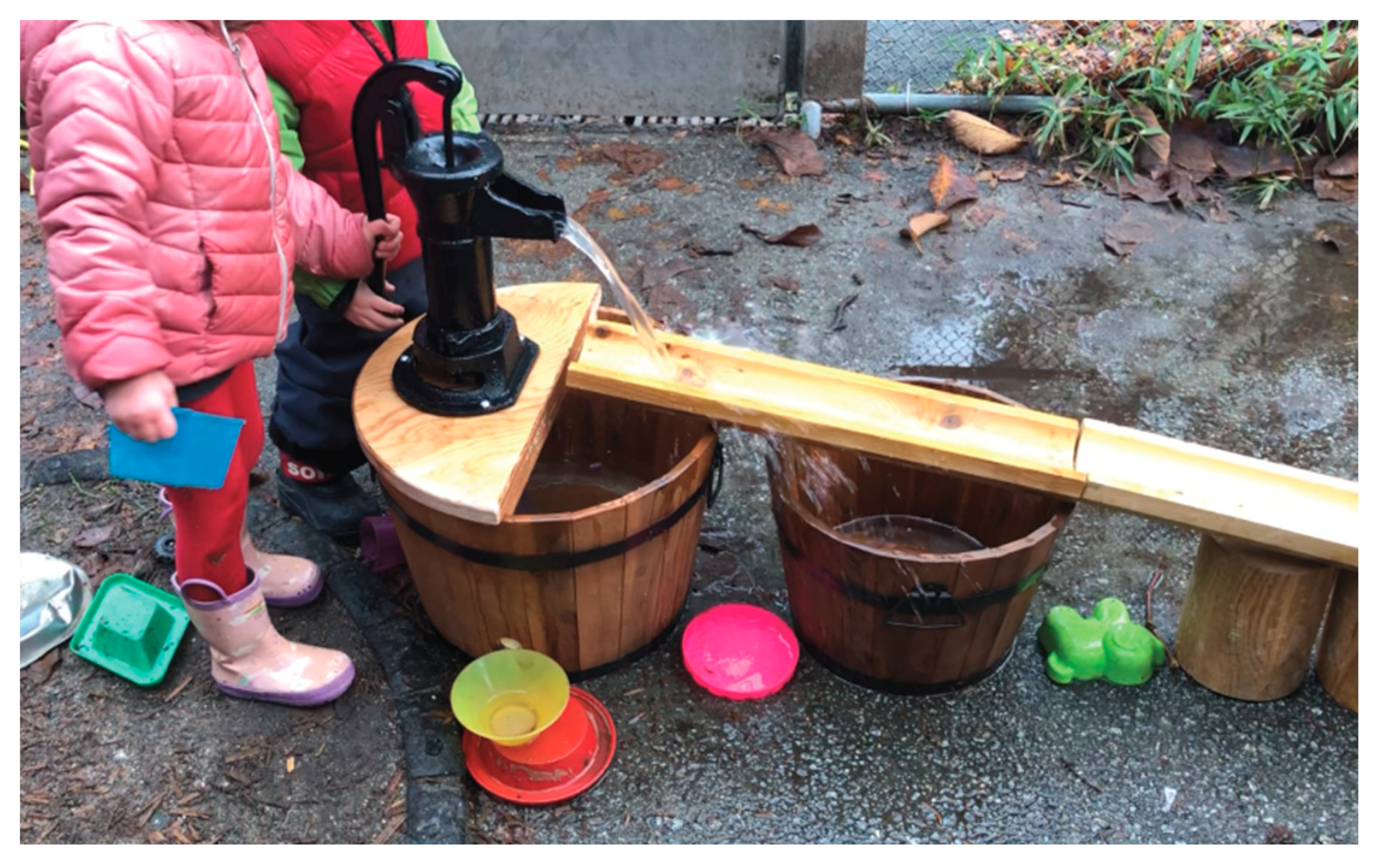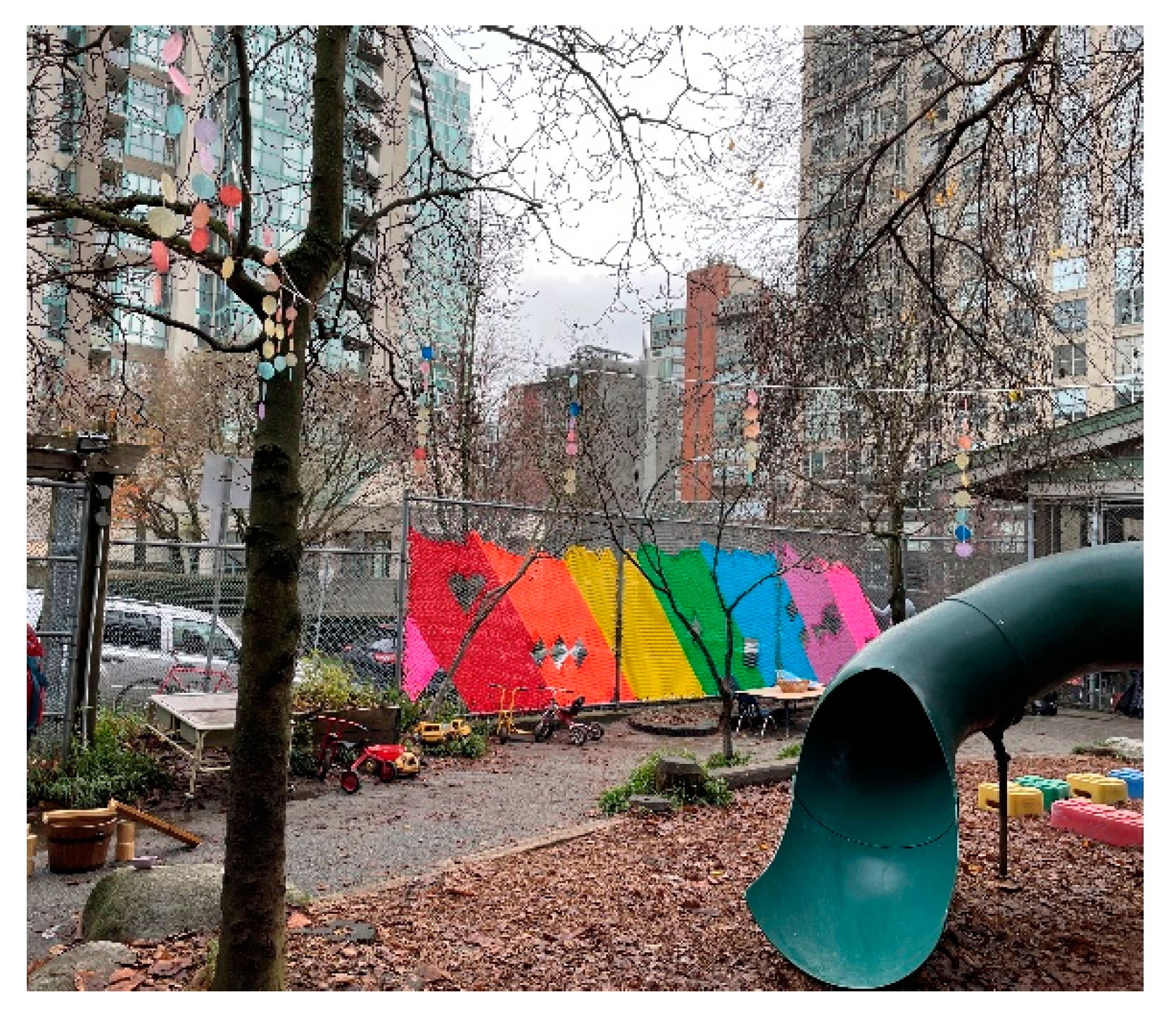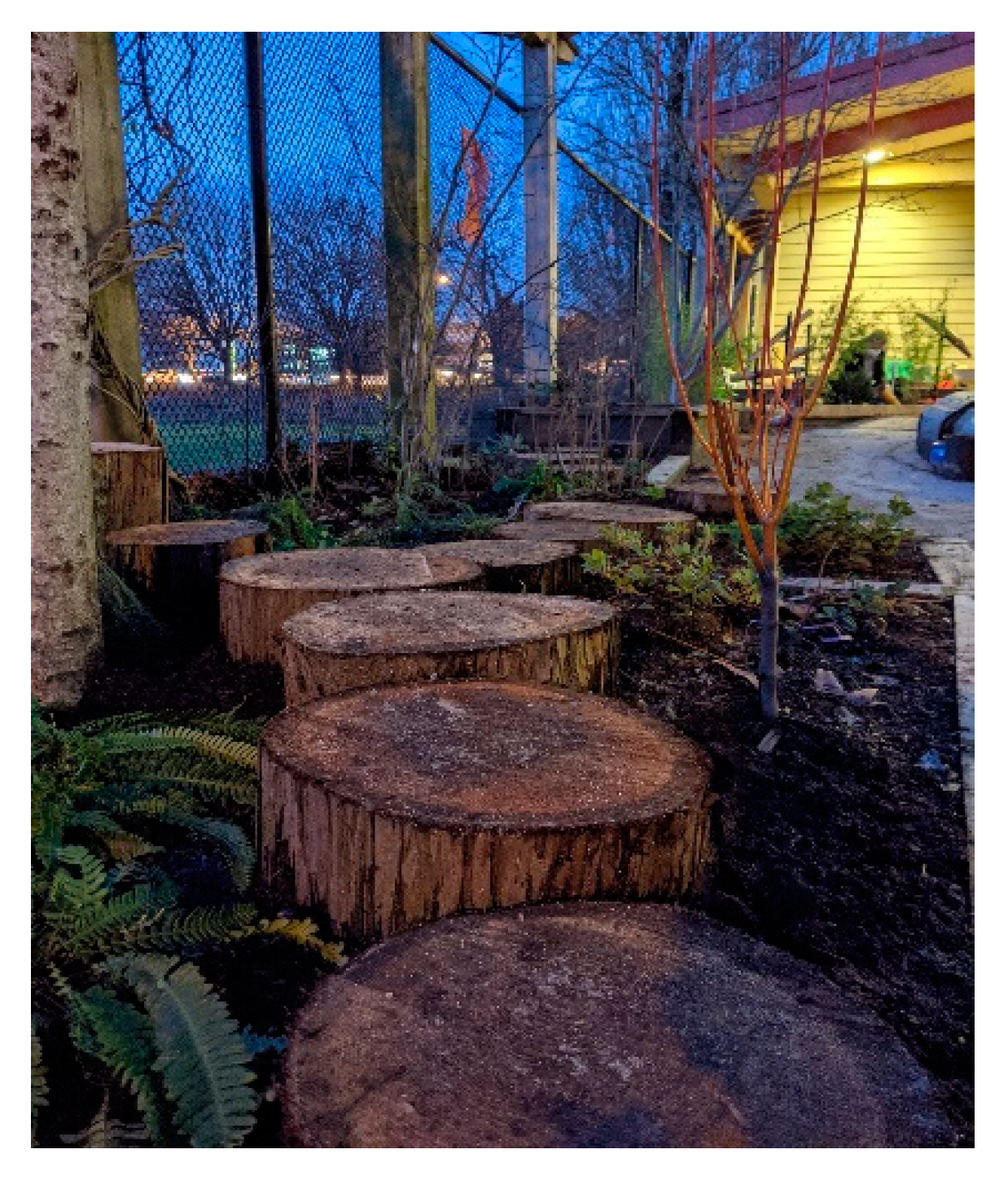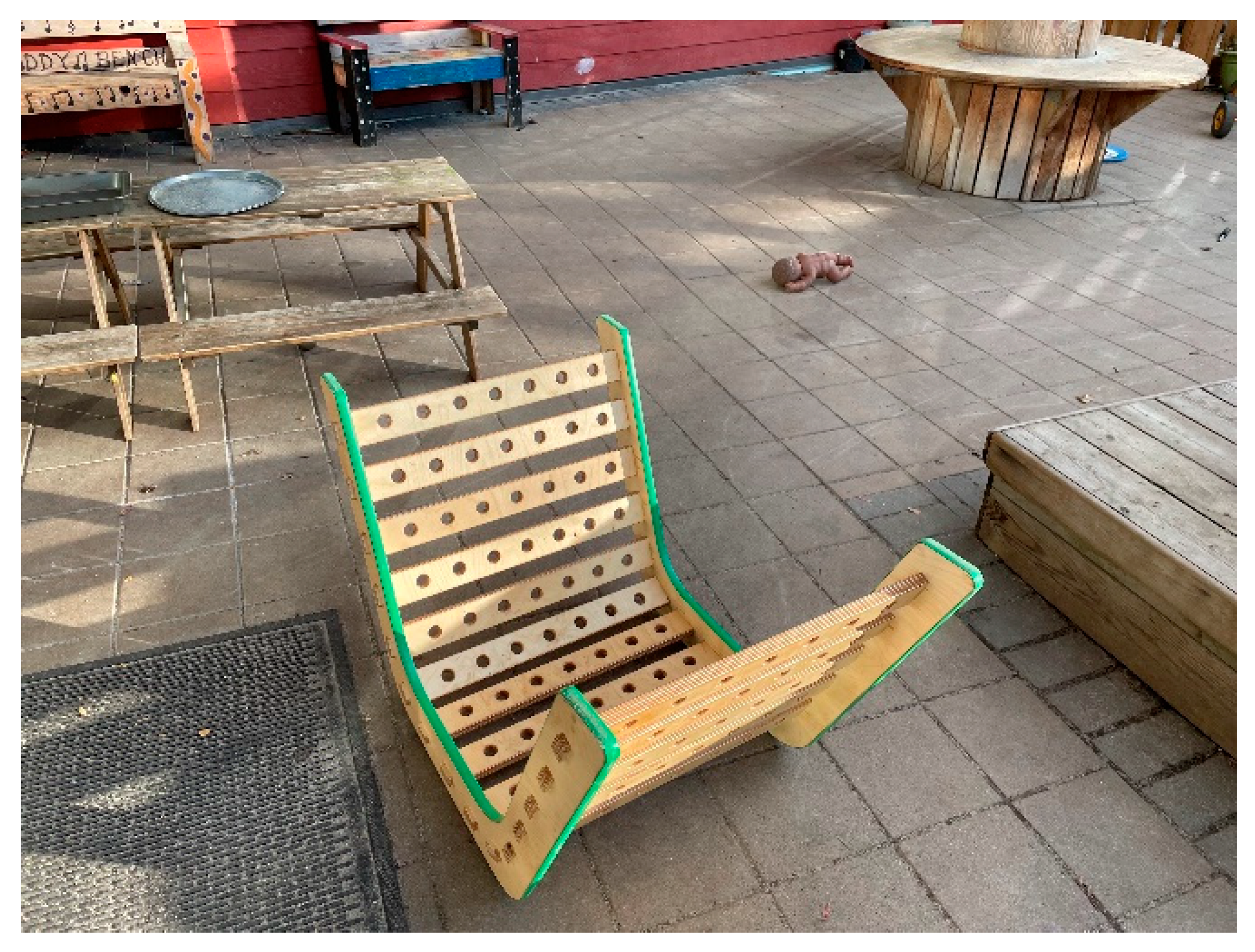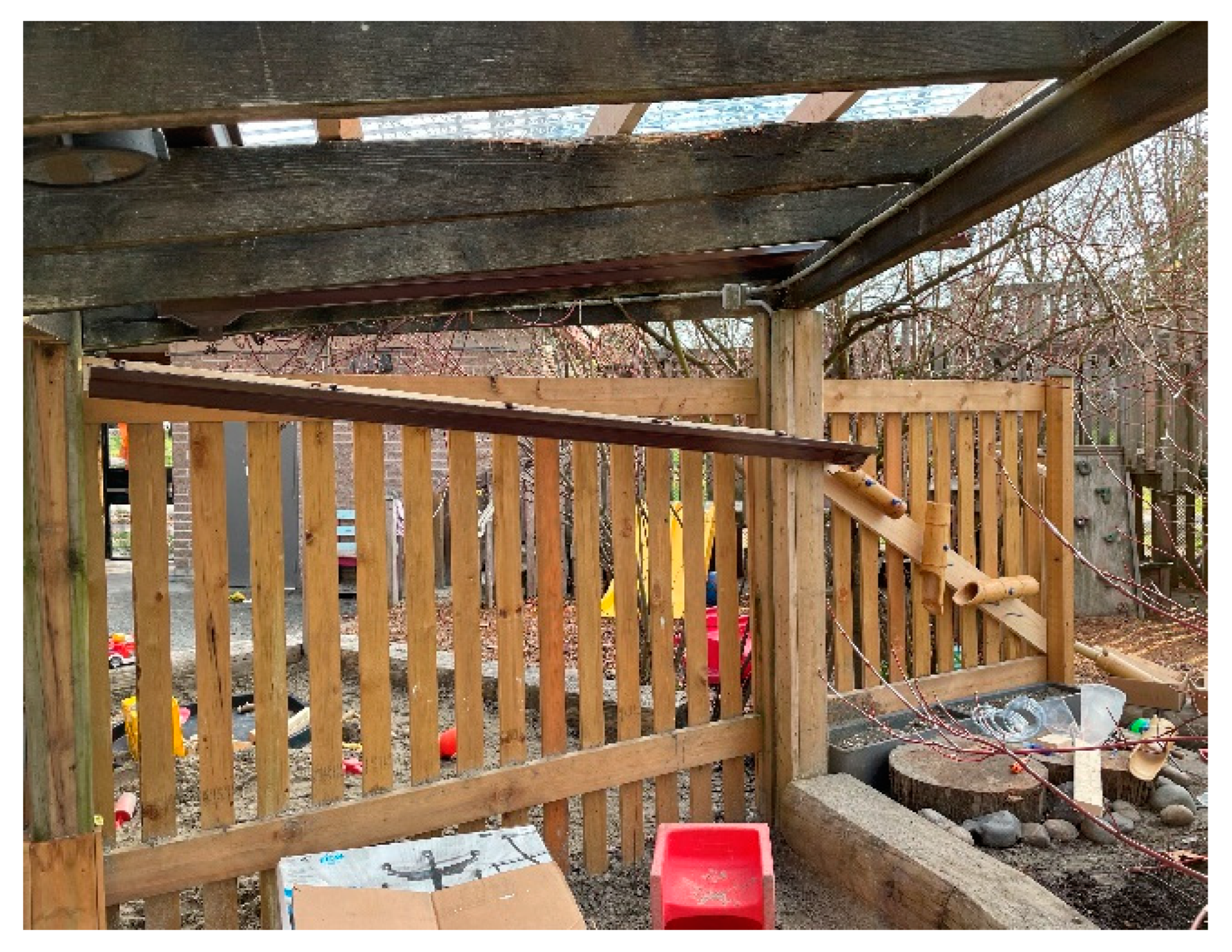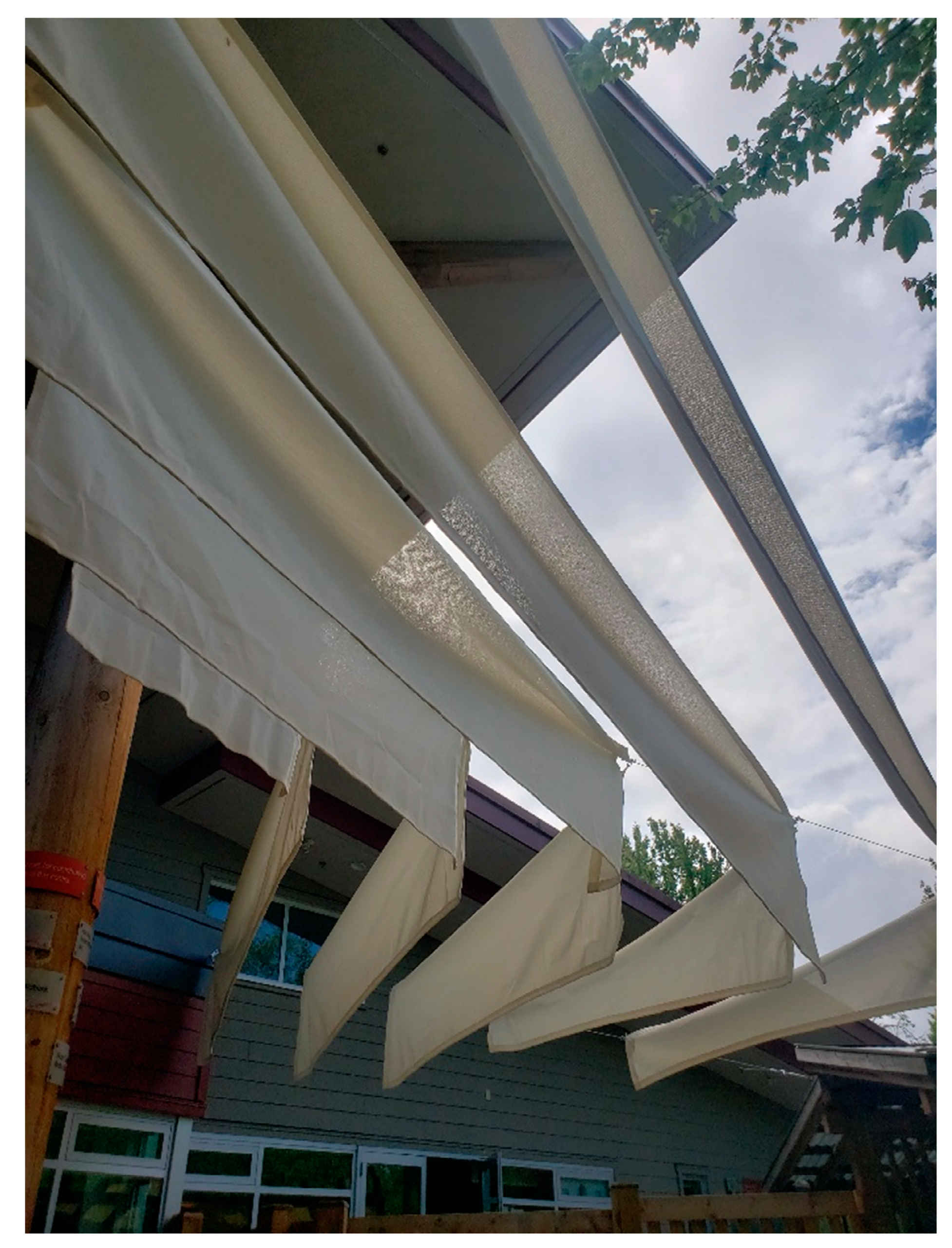1. Introduction
From September through December of 2021, the Rewilding Play Design Build Studio engaged graduate students at the University of British Columbia (UBC) School of Architecture and Landscape Architecture (SALA) to intervene with play features in children’s outdoor play spaces in Vancouver, Canada. The play spaces were located in early childhood education centres (ECECs) operated by the Young Men’s Christian Association (YMCA) of Greater Vancouver. The eight outdoor play areas contained approximately 200 three- to five-year-old children and 48 Early Childhood Educators (ECE). The YMCA staff at these centres were taking part in the PROmoting Early Childhood Outside (PRO-ECO) Project [
1]. Rewilding Play was the only built intervention of the four play-promoting intervention types (the three other interventions involved ECE training, YMCA policy change and parent engagement) of the PRO-ECO Project. Students designed, built, and installed their interventions at four randomized intervention sites from the eight centres. This paper investigates whether the physical interventions (stationary and loose) implemented by the Rewilding Play Design Build Studio enhanced play affordances in the four ECEC outdoor play spaces. The paper further describes the student intervention process, as well as the challenges and successes in undertaking such projects with design students and ECEs.
2. Materials and Methods
Theoretical Context. The term rewilding was borrowed from the field of ecological conservation, the practice of rewilding initially involved the recreation of extinct biotic systems and novel natural systems [
2]. Rewilding in the conservation context provided an alternative to traditional species preservation and restoration, and it prompted environmentalists, ecologists, and landscape architects to design self-sustaining ecosystems, and to strengthen the wild look and function of landscapes [
3]. In an outdoor childcare context rewilding aims to return nature play and risky play to children’s experiences with the outdoors, aspects of play often removed from contemporary childhood in Canada.
Rewilding Play replicated and scaled-up the study design of the Nature Play Meets Risky Play project [
4]. This project involved built interventions of natural material and risk-affording elements for children aged three to five years-old at two ECECs’ outdoor play spaces in Vancouver, Canada. The student interventions were based on the Seven Cs design guidelines [
5]. Researchers compared children’s social/emotional health and play behaviours before and after the installations. They found that inexpensive, physical interventions benefited childrens’ social/emotional well-being and increased nature play and risky play. Rewilding Play also replicated dimensions of the EnCompetence Project in Norway [
6], which engaged ECE in the design and research process and emphasized play affordances.
In addition to designing interventions for play, students were also tasked with creating ideal solar conditions for play. As a component of the PRO-ECO project, Breann Corcoran was examining the relationship between the solar exposure at the YMCA outdoor play spaces and children’s play behaviour. Students were required to determine the extent of sun exposure at each of the eight ECEC sites. For centres with excessive sun exposure, students were asked to propose interventions that created dappled light.
The focus on dappled light instead of shade is an important one. According to Edward Tufte, “Dappled light is produced when sunlight is filtered through the leaves of trees. The dapples result not because tree leaves have elliptical holes in them but rather because the leaves combine to make many tiny pinhole cameras, which then produce multiple images of the sun’s surface on nearby projection surfaces” [
7]. As leaves move in the wind so do the patterns of dappled light on the surfaces of the environment, giving a buoyant quality to the experience of this filtered light. Since dappled light is most commonly produced by mature trees, students were encouraged to explore how dappled light might be produced by modified canvas shade structures since, economically, it was not possible to transplant fully grown trees.
Intervention Design Methods. Rewilding Play interventions incorporated the Seven Cs design guidelines, which describe how the Character, Context, Connectivity, Change, Chance, Clarity, and Challenge of outdoor play spaces can be designed to promote the development of young children [
8]. Students attended a Seven Cs workshop and were trained on the Seven Cs evaluation form [
9]. Design work was also predicated on theories of affordances and loose parts. The theory of affordances posits that an environment, and the objects and features in that environment, afford the possibilities for different types of actions [
10,
11,
12]. Affordances are particular to the type of environment and the type of individual using that environment, so the affordances in an environment will change for children as they develop. The theory of loose parts was also incorporated into the intervention design approach. Coined by Simon Nicholson in his 1971 article, “How NOT to Cheat Children: The Theory of Loose Parts,” loose parts entail materials and objects that can be manipulated by children in multiple ways based on their own desires and inclinations [
13,
14,
15]. Students were asked to consider how inexpensive natural loose parts could be made part of their intervention approach.
Rewilding Play was also guided by the Two-Eyed Seeing model, which seeks to combine Indigenous ways of knowing with Western ways of knowing, taking the strengths of each approach, and working to decolonize the outdoor play spaces for young children [
16]. To support this integration of traditional knowledge and practice with Western approaches to design, the studio received funding from the UBC Faculty of Applied Science to engage Lori Snyder, a Métis herbalist and educator. Snyder has extensive knowledge of and practice with native plants. Her workshop with SALA students helped them select and care for Indigenous plants to be used as part of their interventions in the outdoor play spaces. Snyder also donated a significant amount of plant material, which students harvested from her garden in the Moberly Arts and Cultural Centre in Vancouver, to the project.
The Studio Format and Budget. Student-led site analysis and design work addressed all eight sites. Each intervention site had a budget of CAD 4000 provided by the YMCA, and an extra CAD 2000 from BC Cancer for any shading-related design proposals. Fourteen students worked in four teams comprised of three to four people. Each group selected one intervention site and one control site. Each of the student teams comprised students with specific roles. Workflow student(s) maintained scheduling of any bookings of the SALA Digital Fabrication Labs, and they were responsible for sending files to this lab. These student(s) also maintained the schedule of construction work, assembly, and deliveries, as well as the tools and materials to be acquired. A finance student maintained a spreadsheet with materials and costs, and they coordinated payment to suppliers with SALA finance managers. The communication/documentation student was the lead contact with ECE, maintenance people, consultants, and licensing officers. This student documented the design process, construction work, and assembly, with photos and/or video and notes. A Teaching Assistant also provided assistance to all four student teams.
Resources. Each student team was given plan view drawings of their intervention and control sites in Illustrator and Rhinoceros (Rhino), a 3D computer graphics and computer-aided design (CAD) application software. They also had information about the centers themselves and the contacts for each centre’s PRO-ECO Project champion (the lead YMCA ECE at each centre), the YMCA maintenance staff, and the British Columbia Licensing Officer responsible for the centre. Ample photos of all the centres’ outdoor play spaces were also made available as COVID-19 restrictions prohibited site visits until the end of September.
A number of different textual resources were made available to students including the City of Vancouver Child Care Design Guidelines [
17], The Canadian Child Care Federation toxic plant list [
18], Inspiring Scotland and Play Scotland’s Loose Parts Tool Kit [
19], as well as the Risky Play Meets Nature Play project. Students were provided links to Canadian shade audits and sun safe guidelines [
20,
21]. Students also made field trips to local nurseries and a landscape supply centre which specialized in locally sourced material.
Like many architectural schools, students benefitted from crucial human and infrastructural resources for workflow and tooling needs. These included a rough building room with gardening equipment, such as shovels, rakes, and wheelbarrows; a traditional woodworking shop, with machines and tools to shape and assemble wood and other materials; and a Digital Fabrication Lab with a trained supervisor. The Digital Fabrication Lab manipulates materials by directly reading data sent from students’ computer files, and it enables the creation of elements that are too complex or detailed in shape to make in the traditional woodshop.
3. Procedures
Preparatory Work. A reframing exercise asked students to recall their own memories of playing outside as children. Students met in groups to discuss childhood memories and attempted to recall in as much detail as possible their favourite and most vivid childhood experiences outdoors with elements like plants, water, sky, sand, insects, or in a special place or with nature-related activities like gardening. Key questions asked:
What were some of the key sensorial aspects of this experience?
What did you enjoy about these experiences?
Were there any risks in this experience?
Did you feel a sense of wonder or mystery?
Were there moments when you felt the power of natural elements?
Or you felt responsible for taking care of nature?
Why do you think this memory has stayed with you?
Next, each student reconstructed this experience with a drawing and/or model. This work could be hand drawn, collaged, computer generated, or contain living material–anything that best represented this experience (
Figure 1 and
Figure 2). After students presented these works to each other they hung them up at their desks for inspiration.
Data Collection and Analysis. During the first week of September 2021 students were introduced to the concept of Rewilding Play, the Seven Cs, and the PRO-ECO Project. Students were given a presentation on the insights of ECE regarding their outdoor play areas. These insights were based on the results of focus groups conducted by the PRO-ECO research team with each participating centre the previous summer. In general, ECE wanted more nature play, more natural loose parts (many centres complained of too much plastic in the play environment), and opportunities for risky play.
Scoring on Seven Cs elements were collected via the Seven Cs evaluation forms. Developed by Julie Mountain using the original Seven Cs rubric, the form was adapted for the Nature Play Meets Risky Play project to allow for scoring of each element of the Seven Cs. With seven categories beginning with the letter “c”, the Seven Cs address the physical quality of the outdoor play environment and aspects of this environment which affords children’s play and development. A play space can be assigned a maximum score of 135. This includes up to 25 points for Character, 25 for Context, 15 for Connectivity, 20 for Clarity, 15 for Chance, 25 for Change and 10 for Challenge.
Each student completed the Seven Cs evaluation form for both their control sites and intervention sites. Students were asked not to discuss their evaluations with each other so as not to influence their scoring. The scores were then reviewed by Herrington and a final score was assigned to each site.
Each group performed a solar analysis of their intervention and control sites. Most teams conducted their solar analyses using Rhino software with the plans of their site, and topographical/height information sourced from VanMap and Google Earth. Students were asked to select 21 June 2022, reflecting Spring Equinox, and model the sun at 11 am, 12 noon, 1 pm, 2 pm, 3 pm; and analyze the modeled sun patterns in the main playing areas of the play space (
Figure 3). The following metrics were developed by Corcoran and Herrington to assist students with decisions around shading interventions.
If only one hour or no times were sunny then no shade element was required. In this case, students were asked to look for ways to bring sun in as the center was not meeting the Vancouver Child Care Design Guidelines.
If there were areas that had four to five consecutive hours in sun, then the site needed solar modification with an intervention.
If there were areas that had three to four consecutive hours in sun, then students were asked the following:
- i.
Is the site south or south/west exposed? (Yes/No)
- ii.
Is there limited/no shade, i.e., no trees and/or shade structures on site? (Yes/No)
- iii.
Are the ground surfaces made of sand, asphalt, concrete and/or water? (Yes/No)
- iv.
Are nearby building walls white or light coloured? (Yes/No)
If they answered yes to 3 or more questions below, then the area needed a dappled light intervention.
The Intervention Site Analysis and Scoring. For brevity’s sake, the analysis and scoring of only four intervention sites are described. They are identified by the nicknames that students ascribed to their teams.
Little Bunny Team: Emma Gosselin, Prashi Malik, Kimberly Wong, Yueying Zhang
Little Bunny received the second highest pre-intervention Seven Cs score with 94 out of 135. It was the largest of the four interventions sites with a series of looping paths which afforded ample room to play and run (
Figure 4). As such, it received the highest pre-intervention score, 12, for Connectivity. A low wooden fence between the Little Bunny play space and the outdoor play space for the toddlers created opportunities for dialogue across the fence between children and the ECE. This is reflected in the score of 19 (tied for highest with Crawley Cubby) for Context. Unfortunately, many plants were dead.
The Little Bunny site also featured a sloping terrain. The small hill could be used for sledding and running down, which provided Challenge, but ECE were concerned that children liked to run into the building with their sleds. The facility’s natural wood climber had been removed leaving a large expanse of wood chips and a dead space that no one used (
Figure 5). This accounts for the low score of 5 out of 10 for Challenge.
The ECE noted that the children would like natural loose parts. Students identified an intense sun pocket between the shade structure and the building, precisely where children and staff exited the centre.
Puzzle Blocks Team: Tyler Adam, Janice (Jingrong) Chen, Steve (Fuhui) Li, Will (Wei) Xiao
Puzzle Blocks was the most challenging build site as it was entirely on-structure (the second floor) and all material had to come up through the elevator (
Figure 6). Puzzle Blocks received a pre-intervention Seven Cs score of 66 out of 135, the lowest combined score of the four centres and the lowest score across the six of the Seven C categories. Like many on-structure play spaces there was an excessive amount of concrete and glass, and numerous plants were dead due to the previous summer’s heat dome as the excessive heat experienced on rooftop structures. This contributed to lowest scores for character, context, chance, and change. Concrete pavers and the walls of planters guided children’s movement, but the narrow dimension of the paths confined this movement, resulting in accidents among tricycles. This is reflected in a score of 9 out of 15 for Connectivity, only one point higher than Water Pump, and the lowest score for clarity. At the middle of the site there was a one meter-high, elevated platform with a slide, providing little or risk taking. Puzzle Blocks received the lowest Challenge score of 2 out 10.
There was no provision of shade in this slide area, except underneath the platform. The entire play place space faced west and architectural glass surrounded three sides of the site, making the Puzzle Blocks very hot and sunny. As with many of the centres in the city, Puzzle Blocks also contained a covered area where fake grass had been installed, which the ECE complained made the area even hotter (
Figure 7). The ECE noted that the spaces needed excitement and things to manipulate that were not plastic.
Water Pump Team: Charlotte Chen, Julianna Neudorf, Veronica Sheng
Water Pump received a pre-intervention Seven Cs score of 77 out of 135, the second lowest of the centers. The majority of the ground plane of the play space was primarily dirt with broken irrigation heads and only one looped path. This gave Water Pump the lowest score for connectivity, 8 out of 15. There were lots of plastic loose parts, but few opportunities to play with natural loose parts. The play area contained a large sand area that was popular. It also had a small wooden playhouse and wood climber, but the ECE noted they were seldom used. Tied with Little Bunny, Water pump had the second lowest score for Challenge, 5 out of 10.
The yard had some mature deciduous trees, but many plants had died or had been removed and not replaced. The Water Pump site was sloped with the grade descending into the childcare building (
Figure 8). According to the ECE, the children liked running up and down the slope, but when it rained water rushed down into the building entrance overwhelming the drain. The play space was located next to a major bridge leading to downtown Vancouver, and the majority of the north side of the site looked under this bridge. The chain link fence was transparent and the recent removal of bamboo plants by maintenance staff increased visibility between the two spaces (
Figure 9). The ECE noted that children frequently witnessed adults engaged in inappropriate activities taking place under the bridge, and they felt it necessary to sometimes prohibit children from playing in that part of the play space. This resulted in Water Pump receiving the lowest Context score of 10 out of 25.
Crawly Cubby Team: Ivana Lexa-French, Marie Pudlas, Beau Wuthrich
Crawly Cubby received a pre-intervention Seven Cs score of 97, the highest score of the four centres. Although the site was flat and the smallest of the four intervention sites, it contained trees that were part of the play area and the ECE felt comfortable with children climbing one of the trees (
Figure 10). The site was also adjacent to a large public park and made the play space feel like an extension of the park, offering direct views of vegetation. This increased Character and Context. Unfortunately, large stones and river rock, which was not a suitable fall surface, surrounded the base of the climbing tree, and views of the park sometimes exposed children to inappropriate adult activities. The site’s main play structure provided a single climbing wall, however there were few other opportunities for climbing and balancing on site. The ECE reported the need for more gross motor play and activities. The primary pathway on site formed a loop facilitating movement, however there were few alternative pathways, limiting overall flow and exploration through the site. A series of low planter beds lined the main pathway, but the beds were bare dirt for most of the year and children were not allowed to enter them. The largest open space on site was a tiled area along the window on the west side of the building. This space received direct afternoon sun, which was absorbed by the glass and tile to create an intense heat island effect. The ECE also expressed that the sandbox was uncovered, and that the sand would often get too wet to play in on rainy days, of which there are many in Vancouver.
Intervention Design Process. With an in-depth understanding of their site, ECE and children’s needs, and the goals of the Rewilding Play studio, student teams engaged in a four-hour-long design charrette for both their intervention and control sites (
Figure 11). Design charettes are interactive brainstorming sessions where students draw, model, and test as many ideas as possible. Design proposals for interventions at all eight sites were put together by each group and presented to SALA faculty, professional architects and landscape architects, and PRO-ECO representatives for advice. After students adjusted their proposals based on this feedback, they presented their drawings to the ECE while walking through the play spaces so that ideas expressed in the drawings were understood in situ by ECE for feedback.
Students also engaged in an Indigenous Plant Workshop with Métis herbalist/educator Lori Snyder at her Moberly Cultural Herb Garden in Vancouver. Students learned about caring for the plants that they were removing from Snyder’s garden and relocating to the UBC campus (the plants needed to be removed immediately, but the install date was not until November). The major takeaway from the workshop was the importance of human relationships with plants. Snyder advised that the plants had always lived in her garden and that they would be shocked when transferred to UBC. She advised that we talk and even sing to the plants so that they felt welcomed at UBC, and ultimately their new home at the ECEC centres. This idea factored into a project in December by Lexa-French who was musically inclined.
The month of September concluded with a final charette for the intervention site only. This charette emphasized that the intervention should be inexpensive, locally available, natural and non-toxic. Students were encouraged to reuse durable outdoor elements that were designed and manufactured for completely different purposes than for an outdoor play space. Teams also researched available plant material that was non-toxic and afforded opportunities for children’s play.
In October, students continued iterating and refining their designs for their intervention sites. This work was accompanied by cost estimating to ensure they were not going over budget. Once ideas were firmed up, students video conferenced with YMCA maintenance staff and the licensing officer assigned to their centre. Field trips were also taken to a local landscape supply company and several nurseries. After a pin-up with faculty and lead PRO-ECO PI, Brussoni, students walked through the centres with ECE to explain their ideas and clarify their proposals. Once they reached consensus with YMCA maintenance, licensing officers, and ECE, the SALA students began ordering materials and building in their studio, the woodshop, and the Digital Fabrication Lab.
November commenced the installation of interventions on all four intervention sites. Traditionally planting occurs in spring, but due to climate change planting is now done in the fall. Hot summer temperatures and taxed water systems made sustaining newly transplanted material difficult. The fall months brought cooler weather and less competition from weeds. Unfortunately, November 2021 in British Columbia brought about consecutive atmospheric river events, with much heavier than average rainfall for the region. During such events, plant installation must cease, and in several instances the uninstalled plants were brought under cover. Despite the weather, all installations were completed by the first week of December.
4. Building and Installation Process
Little Bunny. The Little Bunny site combined pre-fabricated and hand-crafted design components. The site’s area of intense sun exposure was outfitted with a custom shade sail. The group added apertures to create dappled light by burning holes into the shade sail with a heated metal implement they designed themselves (
Figure 12). A play shade element in this area involved the installation of trail marker tape over a rigid wire mesh that the students secured over the existing arbour structure (
Figure 13).
In the expanse of bare soil, stepping stones were set among gravel and tumbled sea glass (with a weed barrier underlayment) to form a winding bunny trail (
Figure 14). The trail weaved through Little Bunny Tail perennial grasses planted by the students (
Figure 15). The toddlers watching this installation across the fence were fascinated with the grass, which has soft, fluffy blooms that resemble bunny tails. The students and preschool children picked the bunny tails for the toddlers and the toddler group made up a song to welcome the plants. The preschool children also enjoyed making leaf mulch for this planting area. Fallen leaves can make an excellent free mulch, but the leaves must be sliced into narrow strips for proper aeration (
Figure 16). The ECE asked the children to hunt for yellow leaves only and this provided a lively game. After the installation of this area some of the children began taking home the tumbled beach glass, which they called fairy glass. The ECE used this as a teachable moment to explain that there would be no more fairy glass left if everyone took it home.
The Little Bunny site also received an additional intervention that was beyond the scope of the CAD 4000 budget: a natural wood climbing piece created by the artist, Eric Scragg. The YMCA had been planning to install a climber in this site and provided the extra resources for this addition. The giant roots were remnant of old growth trees felled by the forestry industry in Powell River, British Columbia, Canada. Scragg harvested and brought the heavy wood members down to Vancouver. Herrington, students, a YMCA Carpenter, and a SALA woodshop technician helped Scragg locate, assemble, secure, and sand the piece (
Figure 17). The roots were positioned with an excavator and arranged with two-meter clearance around for the fall zone specified by the licensing officer. They were secured to each other with anchor bolts with wood plugs to avoid water buildup. Rough trimming of the roots with a chainsaw was undertaken to avoid any potential head entrapments. The sanding process took two weeks to bring the surface to a level of smoothness required by the licensing officer.
Students also installed grow bags, soft canvas planters, at the base of the building where children hit the structure with their sleds. This solution offered the thrill of careening a sled into a wall, while providing a cushioned impact to avoid serious injuries. During the non-winter months, the planters provided a planting area for the ECE and children (
Figure 18). The Little Bunny team also brought the children rough, unsanded stumps for play. The licensing officers discussed with the students how rough stumps could potentially cause slivers, but they approved this material as natural loose parts with acceptable risks.
Puzzle Blocks. The Puzzle Block team focused on a puzzle concept early on in their design process. Initial iterations resulted in numerous ideas where the outcome was a singular solution to the puzzle. Yet the students knew that the children would get bored of this solution quickly. They eventually settled on the format of puzzle boxes to create a puzzle with a large variety of outcomes, and wherein the puzzle pieces themselves could afford a variety of functions as space-making stackable cubes. This outcome emphasized the need for designed objects to provide flexibility and variety in function in order to offer higher play affordances. The team worked closely with SALA technicians in the woodshop to develop cubes of marine-grade plywood with sturdy joinery (
Figure 19). Students placed elements inside the boxes so that when the children moved them they made a sound. The boxes themselves had to be highly durable for children to stand and sit on. Using non-toxic paint, students created images of humans, animals, and plants on each side of the boxes (
Figure 20). Once the images were dry, a non-toxic oil was applied to help the blocks withstand the elements (
Figure 21).
Many native plants from Lori Snyder’s garden were installed at the Puzzle Blocks planter areas. Students removed existing dead plant material and replaced it with these native plants. The team also installed new native plant material from nurseries around the climber. They selected beautyberry shrubs which produce clumps of bright purple berries in the fall and early winter. Once established the plants will not only provide dappled light, but the berries will also provide non-toxic play props. Using a staple gun, the team adhered camouflage netting to the empty structure over climber to provide dappled light.
Unfortunately, the fake grass could not be removed because it had been attached to the water-proofing membrane of the roof (which was the play surface ground of the children’s play area). Puncturing this membrane would compromise the building envelope and potentially cause substantial damage to the building’s integrity. As an alternative to replacing the fake grass, the team installed an interlocking real wood flooring system over it to intercept children’s interaction with this plastic material and to provide a unified, flat surface for large scale loose parts play. To reduce the heat buildup in this covered area the team installed camouflage netting (that was out of children’s reach) in combination with gourds, which the students cleaned and treated with non-toxic preservative (
Figure 22).
Water Pump. The Water Pump team combined many prefabricated elements in unusual ways. In their site walkthrough with ECE, they noticed that a covered water faucet sat atop the sloped terrain, but it was surrounded by dirt and there were no options for waterplay. The team purchased a cast-iron pitcher pump that they affixed to a wooden planter, which was water proofed with a liner (
Figure 23). The pitcher pump was designed for adult use and weighing sixteen pounds, so the students knew children would find it challenging to pump. They also purchased wooden troughs and blocks, which children could arrange to make water cascade down from the planter.
To bring more explorations of nature the team planted ornamental grasses in the open expanse of dirt. Spatially, the grasses change dramatically over time and this would add changes to this area as well (
Figure 24). They also placed boulders and stepping stones through this area to encourage exploration. Chimes, that would capture the movement and sound of the wind, were strung up over this area.
Wild strawberry plants from Lori Snyder’s garden were installed in the empty planters along the chain link fence. But the transparency of this site fencing, along the side bordering the bridge and the side facing the street, presented the biggest challenge for the team. They decided to weave trail blaze markers in a bright colours along the street side. Openings were created with the weave so children could see out to the street (
Figure 25). At the bridge side students employed outdoor vinyl banners in a novel way. These advertising banners are ubiquitous in Vancouver’s cityscape. They are typically stretched across construction fencing and depict fancy new real estate developments. The students discovered that the banner company could print any high-quality image on the surface of the banner, so they affixed to the fencing a banner depicting giant starfish near the children’s sand play areas and near the newly planted area they affixed a woodland and stream scene (
Figure 26 and
Figure 27). This woodland view was very effective in providing an optical illusion (
Figure 28). Importantly, both banners blocked views of activity occurring under the bridge.
Crawley Cubby. The Crawley Cubby site focused mainly on developing customized designs for outdoor play. Pre-fabricated designs have higher costs, so hand-crafting their design lowered the budget and allowed for a higher planting budget. The existing planter beds had sparsely planted trees in compacted soil, so the group added new topsoil and mostly native plants as groundcover. A path of tree stumps was also placed through the planting beds, so that children could move among the plants without stepping on them or disrupting the topsoil (
Figure 29). The path extended into an abandoned rocky corner, which was unusable due to large boulders and river rock covering the ground. The group moved the boulders to form appropriately spaced steppingstones and aligned these with additional tree stumps to complete pathways moving between the river rock. Clusters of bamboo plantings were added to give the pathways a sense of seclusion while maintaining visibility of the children. The children were very excited by the installation of the bamboo plants, grabbing toy shovels to help dig, and volunteering to help arrange the river rocks between the steppingstones.
The now-empty corner was close to a water spigot, so they turned it into a space for water play, with the installation of bamboo water instruments custom-designed by the team. Magnets were attached to the bamboo so that it could snap onto fasteners tilting the bamboo in two different directions to alter the course of water flow (
Figure 30). This concept was also brought onto a wall next to the sandbox. The sandbox was entirely uncovered, and the group responded by installing a clear roof, which drained into a water wall with more bamboo pipes. The rain thereby became an opportunity for play, rather than a hindrance.
The most intricately designed part of this intervention was the Crawley Cubbies. These required significant time in the Digital Fabrication Lab with technicians, as well as research on materials and assembly that relied heavily on one group members’ previous experience in carpentry. The design responded to the need for medium-sized loose parts, which allow children to create their own flexible and imaginative spaces within the ECEC. The team developed the Crawley Cubbies as modular forms providing walls or tunnels that can combine together into larger forms, while affording a variety of physical play experiences such as climbing or rocking (
Figure 31,
Figure 32 and
Figure 33). They selected Baltic birch plywood as a material for its strength and durability. Several coats of non-toxic weatherproofing were applied to the plywood as well. Plastic T-edging protected the edges and was sourced from an arcade machine shop for a bright selection of colours (
Figure 34).
One team member was an experienced sailor and she used her marine hardware knowledge to help design a custom shade sail. The roof of the ECEC had a highly irregular shape that protected the site from mid-day sun but exposed both the indoor and outdoor spaces to hot afternoon sun (
Figure 35). The roof shape also made conventional shade sails ineffective and impossible to install. In response to these conditions, the group designed a shade sail made of vertical fabric banners, increasing in size to form a partial pyramid shape. The installation of this form required numerous fasteners used on sail boats to attach the shade sails to the ECEC building and endure the rainy climate. The final form not only blocked out the afternoon sun, but as the banners rippled in the wind it created an effect of soft white waves in the sky.
5. Post-Installation
Plant posters. For their final assignment, students were asked to research the maintenance regime of the plants they had installed at the ECECs. It was recommended by the ECE that children aged three to five years-old could perform the following tasks:
Pull weeds in and around the garden
Help water plants in appropriate amounts
Protect the garden by picking bugs like grubs and beetles off of plants
Pick berries or other edible plants
Deadhead (remove old flowers)
Remove sticks and dead branches (branch removal can easily be done by hand on bamboo plants)
Sing and talk to the plants
Based on this information from the ECE, students created posters depicting a plant maintenance calendar (fall, winter, spring, summer) for ECE and the children (
Figure 36).
Singing with Plants. Singing with Plants was a subsequent project completed by co-author and former landscape architecture student, Lexa-French. The project was based on a consultation with Lori Snyder and sought to embody Indigenous knowledge and values Snyder promoted around plants and ecology. The final format of songs and illustrations was selected to communicate directly with the children of the ECECs. The songs were structured as dialogues between plants and people, embodying knowledge about the plant’s characteristics, as well as Indigenous plant values. For example, the Bearberry Song featured a dialogue between a kinnikinnick plant and a child wanting to pick all the berries, leaves and flowers off the plant. The kinnikinnick plant explains the importance of keeping its leaves, flowers, and berries for other animals and insects. This song carries the value of the ‘honourable harvest’, an Indigenous practice of taking only what one needs and leaving enough for other lifeforms to thrive. The chorus references kinnikinnick’s other common name, ‘bearberry’, to help children remember the plant name as well as associate it with the charismatic megafauna it supports as habitat.
6. Results
All four intervention sites received physical interventions for play and three of the four sites received dappled light interventions [
22]. The sites pre- and post-Seven Cs evaluation scores are presented in
Table 1 and
Table 2. They show an increase at all sites, ranging from 10- to 30-point increases.
Each centre received a walk-through with the licensing officer and students before the children were allowed to engage with the interventions. The students were present when the children were allowed to play in the intervened sites. While the PRO-ECO Project will be studying the children in detail, the following describes some of the impressions of the intervened sites and children and ECE engagement.
Overall, the plantings were impacted by exceptionally cold weather in January 2022, and several plants did not survive the extreme weather event. Plantings that endured this event better were mostly hearty, native perennials, which are recommended to resist the increasing number of extreme weather events caused by climate change. The impact of weather on design materials and plantings is commonly studied by landscape architects, and it is recommended to work in such partnerships to ensure the durability and suitability of design interventions. The design students also benefitted from this hands-on experience as they learned to work with researchers and participants outside of their field of study.
Little Bunny. Little Bunny received a post-intervention score of 124, the highest score of the centres. Overall, there was a 30-point increase in Seven Cs scores at Little Bunny, which made it tied with Water Pump for the most points gained post-intervention. The categories of change and challenge witnessed the greatest gains, with change pre-intervention of 18 out of 25 rising to 24 out of 25 after intervention. This is largely due to the 120 little bunny plants installed there. The name of the plant, Little Bunny Tail, and the way the plant’s soft, fluffy plumes resembled bunny tails provided much excitement, inspiring children to make up little bunny songs, dances, and chants. (
Figure 37,
Figure 38 and
Figure 39) Little Bunny was also able to increase the Connectivity of the site with pathways created by the plants. Children immediately began following the path, and the softness of the plants prompted children to try to jump over the plants like a bunny.
Challenge went from 5 out of 10 to 9 out of 10. The natural wood climbing piece maintained the irregular forms of a tree (
Figure 40). Compared to conventional climbing structures, the irregular shape of the climbing piece provided greater play affordances. Unlike climbing structures with evenly spaced repetitive components, the variation of climbing forms in the piece prompted children to judge how to adjust their bodies to the differently shaped and spaced roots. The ambiguity of these forms inspired children to use their bodies in diverse ways and to imagine the piece as different animals. Some children decided they were riding a horse, while others yelled that they were climbing a dinosaur. The wood climbing piece was also more resistant to weathering than cut timber structures. Made from old growth cedar, this tree species is very resistant to rot and mold compared to other types of wood.
Puzzle Blocks. Puzzle Blocks received a post intervention score of 86, the lowest of the four centres, and the least amount of points gained in the overall Seven Cs evaluation. The blocks with their hand-painted imagery contributed to the character category of the Seven Cs. Several ECEs commented that the blocks brought “love” to the play space, which increased the character of the site. At first this description surprised the students and researchers, yet upon further reflection it made sense given the corporate character of the centre and numerous machine-made, mass-produced elements in the space.
The Puzzle Blocks contributed to Chance, Change, and Challenge categories as well. The children could match or mismatch the different animals and plants for chance. Children’s spatial use of the blocks was immediate, however. Children began arranging the blocks into formations on which to sit, stand, or ‘fly’ on their bellies (
Figure 41). This response engaged their entire body in a variety of ways as the blocks were large enough to support them, but small enough to lift and maneuver. When the children discovered that the boxes made noises when moved, this brought further wonder.
There was a one-point decrease in Context because the students were unable to fully address the excessive sun exposure on the site, which has a significant impact on play behaviours and affordances during the summer months. Due to excessive winds on the roof-top site, a standalone shade structure was not permittable. Students applied window film to the architectural glass to decrease sun filtration, but the film was easily removeable (to avoid damaging the glass), and once the children realized this, it did not last as it kept being pulled down.
Water Pump. Water Pump received a score of 107, an increase of 30 points, and this tied it with Little Bunny as the highest post-intervention point gain. The water pump generated the most excitement among children and contributed to gains made in Chance, Change, and Challenge. The pump itself was not specifically designed for children and required a certain degree of strength to operate (
Figure 42). While stronger children could pump it on their own, others had to work together to pump out the water. The trough system required cooperation between multiple children, and this inspired the children to work together. The intervention demonstrated how children welcomed challenges and benefited from a level of complexity requiring them to work together. The Water Pump site’s primary plantings were tall ornamental grasses that broke up an open space into smaller areas and pathways. The children immediately started walking around the plantings, as these simple screens provided avenues for exploration in dappled light.
With a 10-point increase, Context was the largest change evident from all the Seven Cs variations. This was due to the banners that completely blocked views under the bridge, making the entire play space available for play. The ECE were also very happy about the weaving as they brought greatly needed colour to the play space. Since the colourful weave could be seen from a major roadway, the bright colours ‘announced’ the presence of the ECEC to the neighbourhood or as one ECE commented, “hey, there’s a childcare centre here!” (
Figure 43).
Crawley Cubby. Crawley Cubby received 120 in the Seven Cs post evaluations, making it the second highest score of the centre, but only a gain of 23 points. Like Little Bunny, Crawley Cubby was able to increase the Connectivity of the site. The first intervention installed was the tree cookie and stepping stone pathway moving through the planter beds (
Figure 44). Children immediately started using these alternative pathways, embracing the greater risk affordance of uneven steps and gaps to jump across. Character, Chane, Chance, and Challenge gained with a perfect score for Chance 15 out of 15. These gains can be attributed to the Crawley Cubbies elements. Children explored various ways to use them, by rocking, climbing, with one child pretending it was Santa’s sleigh (
Figure 45). Another child tipped her cubby forward while rocking. The Crawley Cubbies were designed to reduce pinch-hazards and curved to tip forward on a gentle slope, so she was unharmed. Unphased, she continued playing on the Crawley Cubby. Like the puzzle boxes, the Crawley Cubbies were large enough to play on, but small enough to maneuver, albeit with some physical effort. The children appeared to enjoy the challenge of maneuvering the cubbies, which became a game for one child in and of itself. The bamboo features also contributed to Character, Chance, Change, and Challenge. One child playing with the bamboo pipes imagined it as a telescope, another a megaphone (
Figure 46 and
Figure 47). Their generic shape afforded more possibilities for imaginative play than the students had intended.
The score for Context decreased by two points because students did not block views to the park because of the benefits of lush borrowed scenery. However, what they had not anticipated was this transparency between park space and ECEC play space attracted park users to peer into the play spaces and, in some cases, engage in inappropriate behaviour.
7. Discussion and Conclusions
Strengths and Weaknesses. The Rewilding Play intervention increased the Seven Cs evaluation scores for every ECEC site by a range of 10 to 30 points, indicating that the stationary and loose physical interventions implemented by the students enhanced play affordances. Further, ECE and children’s reactions to the interventions indicate that multiple play affordances are being actualized in both anticipated and unanticipated ways. The biggest overall gains were made in Character, 27, and Change, which had total increases of 27 and 19, respectively. Plant material typically contributes to these two categories, and plants are typically the least expensive elements of a play space. However, plants need care and maintenance, and they are subject to weather, a weakness identified in the climate change discussion.
This paper also focused on the design and installation of outdoor interventions and the challenges and successes in undertaking such projects with design students and ECE. PRO-ECO’s inclusion of students from UBC’s School of Architecture and Landscape Architecture meant that the students brought their capacity for design, material problem solving abilities, and free labour to the project. Since students were trained in landscape architecture, specifically, they were able to analyse and respond to the unique needs of each of the ECEC sites. Student were also able to visualize their ideas with sophisticated 3D modeling programs that helped communicate these ideas to the ECE, licensing officers, maintenance staff, PRO-ECO Team, and BC Cancer representative.
Replicability of interventions. Teams that decided to custom build their design interventions from scratch could extend their budget further than groups incorporating pre-fabricated design components, which tend to cost more material wise. However, the process of building everything from scratch required carpentry skills, special tools, and additional time, while presenting a greater risk of design flaws. For example, the technical design of the Crawley Cubbies was developed by a student with previous carpentry experience. UBC fabrication technicians supported the team in staging the construction process, and the team members spent extensive hours in the fabrication workshop during the Crawley Cubby construction process. This complex process would be difficult to duplicate. However, teams that used pre-fabricated elements or combined or modified pre-fabricated elements in novel ways provided ideas that could be more easily replicated by others. The Water Pump team’s idea to use commercial banners on the fencing, for example, is an approach that is inexpensive and can be easily duplicated. YMCA maintenance staff surveyed this particular intervention and are currently looking to implement it at other sites.
Teams designing and installing overhead dappled light shade structures provided variable replicability for other centres. The Crawley Cubbies shade structure was designed in a novel series of suspended panels that could be easily duplicated, but the light quality is not dappled (
Figure 48). The Little Bunny shade sale provided dappled light, however, the design involved blow torches to simultaneously pierce and melt the edges of the holes and would not be as easily replicated. Simply puncturing holes in a shade structure fabric can lead to fraying and compromise the material. The edges should be melted to prevent this fraying.
Communication with ECE, licensing officers, and maintenance staff. Communication between students and ECE was an important factor for the students designing and building at the ECEC. The ECE have professional knowledge and experience that informs valuable feedback for the students. This feedback is necessary to support a design process resulting in developmentally appropriate designs for the children. However, one of the greatest challenges was ensuring enough time for the ECE and licensing officers to engage with the students. Particularly in the context of the COVID-19 pandemic, many ECEC were short-staffed and struggling to cope with restrictions added to their work environment. Engaging with design students placed additional work responsibilities onto ECE and licensing officers, and there were numerous occasions where consultation sessions were missed or canceled. While the ultimate goal of such design interventions is to enhance the environments of the ECEC, it is important to consider the time and energy required of ECE to provide consultation for such projects.
The social structure of ECE working with the PRO-ECO project did not always reflect the social hierarchy of the ECEC on the ground. At some centres, feedback and criticism was mainly provided by ECE with dominant personalities who were not working with the PRO-ECO project. It was sometimes difficult for the design students to receive a group consensus from the ECEC on their design proposals. At times this resulted in inconsistent feedback, which complicated the process of design. In one instance, the Puzzle Block group had intended to paint people in certain professional uniforms on the blocks. They suggested inversing genders traditionally associated with these professions in order to encourage the children to think beyond gender-based societal norms. One ECE adamantly refuted this suggestion, asserting that the children preferred normative gender roles. While students did paint one female, Asian chef, they decided to depict primarily animals on the other faces of the blocks, which are usually less gender coded. In this instance, the students sought the professional knowledge and experience of the ECE, however they were also confronted with cultural values that they did not share. Conflicting cultural values are a common challenge in multicultural environments, and it is an important point of consideration for both students and ECE collaborating to support children at such a young and impressionable age.
In other instances, ECE communicated clear needs or concerns to the students. Those students who responded most carefully to ECE feedback generally built better relationships with the ECEC, which positively impacted their designs. Time, organization and clarity were the most important communication factors between students and ECE to support successful design interventions at the ECEC. For example, ECE at the Water Pump and Crawley Cubby sites communicated concrete needs to the students. The Water Pump site needed visual barriers toward the street and the students responded with colourful weaving and visually compelling banners, which not only provided visual barriers but enhanced the atmosphere of the space. The Crawley Cubby site needed a rain shelter for their sandbox, and the students responded by building a roof that fed rainwater into a water wall, turning rain run-off into a source of play. In these successful collaborations, the ECE articulated spatial challenges they faced in supporting the needs of the children. In turn, the design students brought creative thinking to turn these challenges into enhanced opportunities for play.
Unfortunately, during the design interventions the maintenance lead who had been working with the PRO-ECO Project and the students left his position and was replaced with an individual who had no knowledge of the PRO-ECO Project or the Rewilding Play studio. Further, the landscape maintenance responsibilities for the sites varied, with some sites maintained by YMCA staff and others by independent landscape companies retained by the building owners. As a result, the YMCA sites received limited landscape maintenance, so the interventions relied on the ECE to work with the children to maintain regular plant care. The plant care posters provided by the students supported these efforts, and it was important for the ECEC to integrate this knowledge in a timely manner in order to maintain the survival of the plantings installed during the intervention.
The installation of the interventions created a paradox for the students. The YMCA children are required to be outside every day and an overarching aim of the PRO-ECO project and the Rewilding Play Studio is to promote outdoor play. However, many student interventions were installed in situ for approximately four weeks while children were playing outdoors. Keeping children out of construction areas tested ideas of risk, in particular, among PRO-ECO champions, ECE, and licensing officers. Some licensing officers asked students to work with the ECE and to use yellow caution tape to keep children out of installation areas. Other licensing officers viewed any use of tools by students as dangerous to the children and they required students to use snow-fencing secured to heavy-duty posts to cordon off all installation areas. Interestingly, the heavy-duty cordoning with snow fencing piqued children’s curiosity about what the students were doing, and the children often wanted to help the students. This prompted some ECE and students to devise ways that children could be involved, while not being directly inside the construction zone. At Little Bunny, for example, children were asked to find only yellow leaves for the students to cut into mulch. This turned into an intriguing game for the children who searched the play space identifying and picking up only yellow leaves.
Climate Change. Climate change was and continues to be a major challenge. Plants and other building materials must be durable enough to respond to extreme weather events, as well as the sometimes, rough handling by three- to five-year-old children, while also being safe and non-toxic. Planting- and material-durability was a major consideration with regard to both the damp Vancouver climate and summer heat domes. Natural materials, like wood, required non-toxic weather proofing, and ECE were asked to bring certain designed loose parts inside or to the storage shed at the end of each day to extend the object’s lifespan. Measures were taken to ensure durable interventions; however, it was also necessary for ECE to work with children to treat the interventions with respect.
An extreme cold weather event occurred in January 2022, introducing unprecedented periods of snow to the Vancouver area. While native plantings mostly survived, the frost killed numerous other plantings. At Crawly Cubby the frost irreparably damaged the bamboo causing it to crack. Bamboo was chosen as a natural material, however it proved unsuitable for the climate. The Water Pump site also used bamboo in their design, however it was put in storage at the end of each day, rather than permanently installed outside and exposed to the elements. These extreme and unpredictable weather events are a product of climate change. Unfortunately, students were not available to repair the damage caused by cold temperatures and repairs of the design interventions were taken over by ECEC maintenance staff.
Limitations and Future Directions. Scoring of the Seven Cs requires training and some understanding of design and the play affordances of design elements. This limited its use by ECE involved in the PRO-ECO project or even children themselves. Future use of the Seven Cs evaluation form should consider potential simplification to facilitate scoring by ECE and lay persons without specialized training. Researchers seeking to replicate this type of intervention project with design students in their own academic institutions should carefully consider the impact of climate change on construction timing and material selection. Sensitivity to the diversity of socio-cultural values among students, ECE, children, and their families is also important as these values are embedded within design decisions, and within designed forms, plantings, and other symbolic elements.

